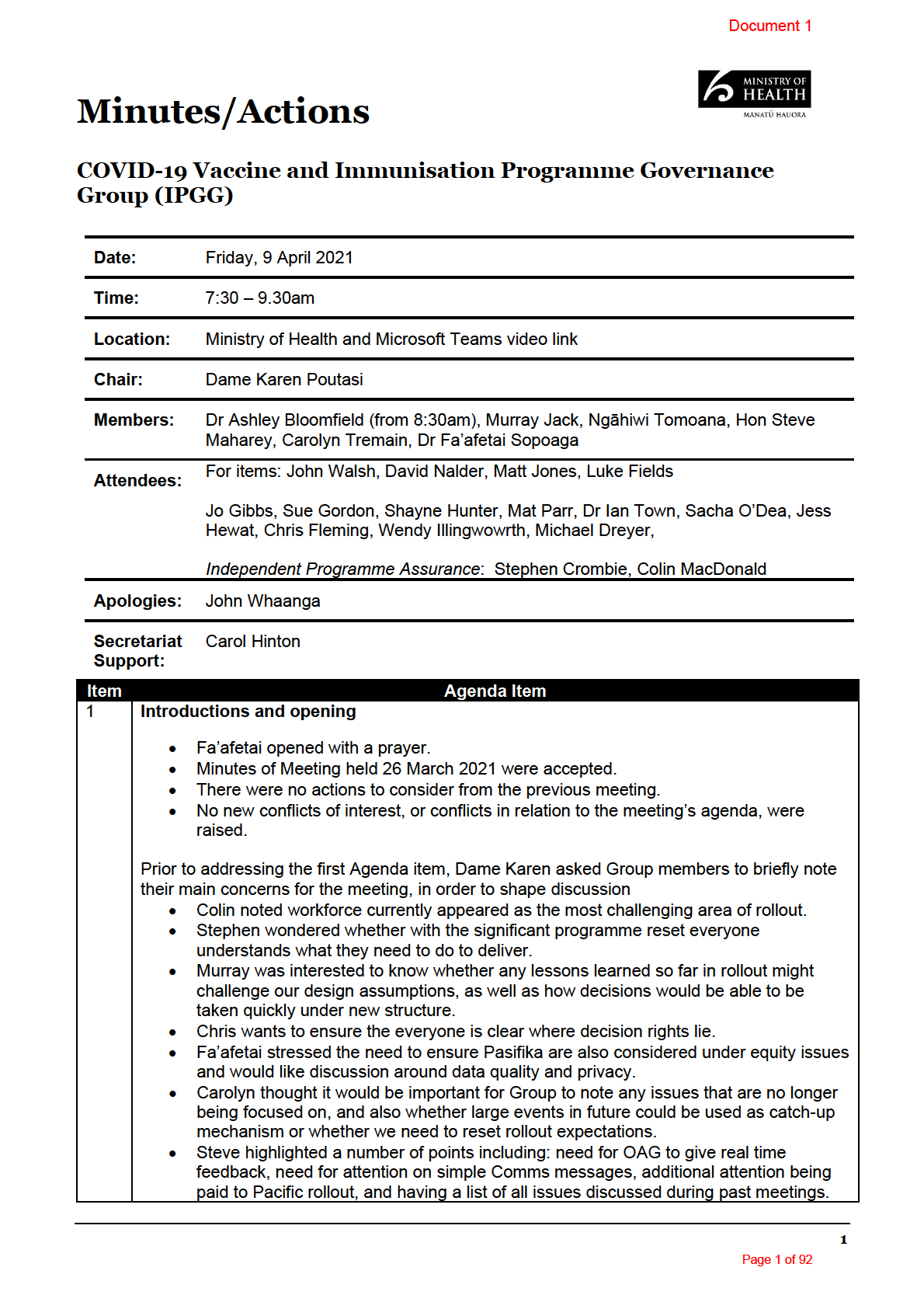
1982
ACT
INFORMATION
OFFICIAL
THE
UNDER
RELEASED
Document 1
• Ngāhiwi wondered whether we wil be able to catch up to expected numbers or if we
need to signal a change in pace.
• Dame Karen stressed the need to understand if our stock on-site is on a consistent
upward trajectory as the stock level is causing some anxiety for Ministers.
2
Programme status and risk summary (David Nalder and Mat Parr)
Paper considered – CVIP Programme Status and Risk Summary 7 April
Paper considered – OAG Performance Audit update
a) Programme status and risk summary
David highlighted the Milestone view and Status slide (p6) in the Status and Risk Summary
1982
• This is a structure to test with the group, and is not yet fully populated
Group Discussion
ACT
• Dame Karen asked how this document could be updated to include a measure of what
has been completed in order to show how Programme is tracking
• Matt replied that the focus over the next week wil be trying to get an operational view
into the document and once things like DHB plans are overlaid in there we should
have a lot more visbilty over performance
• Jo stressed the importance of including in the front of the report the list of things that
have been completed
• Murray suggested the need to clearly articulate the critical dependencies that wil
influence being able to scale up from 10,000 to 50,000 doses a day
INFORMATION
• Mat mentioned that two things they were hoping to build into model within next week
were how to monitor if we were on track or at risk, and how to get document to reflect
how workforce needs at particular points flow through to delivery models.
David next discussed the risks portion of presentation:
• On Slide 9 we can see the top 12 risks related to the programme, reflected on the
different pil ars
OFFICIAL
• Updates this week are mainly providing more content on current activities and future
actions to mitigate risks
• Last slides are looking at inher
THE ent risks within overall end-to-end Programme and
should help us identify where control of that risk sits (Ministry, DHBs, Providers etc)
Group Discussion
• Murray said it would be good to see updated reporting against proposed action
closure dates in order
UNDER to easily monitor progress
• Jo noted that she wil be meeting on Monday with three DHB CEs to draft an
Accountability Framework which should address the final point raised by David
• Dame Karen sought clarification on the process for DHBs to raise issues in the
absence of a central call centre, and asked whether Jo was confident we had a line of
sight to unresolved problems DHBs are experiencing
• Jo confirmed the call centre needs to be beefed up to provide a contact point at least
12/7. The Regional Account Managers are also a good contact point but are ideally for
RELEASED
weekday contacts, although they are currently contacted as needed. The
accountability framework being drafted should address these issues, and there is also
agreement under the new structure to have a Quality and Safety Committee to
complement CV-TAG.
• In response to a question from Colin, Jo said that all CEs are welcoming of the
accountability framework. The framework wil be set up in a way that aligns with
annual plan and normal mechanisms for DHB reporting.
2
Page 2 of 92
Document 1
Action 1: Jo to provide update on Accountability Framework at next Governance
Group meeting
b) OAG performance audit update
David provided update on OAG audit
• OAG have finished substantive work and have sent a small number of residual
questions
• The themes emerging are al risks or issues the Group is aware of
• Draft report is expected 19 April then Ministry wil have two weeks to provide response
• Intention is for document to be published mid-May then tabled in Parliament
Jo noted that by mid-May programme should be moving into Tier-3 so wil be at very different
stage than when information gathered.
1982
Dame Karen suggested that the important thing wil be to workout when it wil land and how
we can use it constructively at that time.
ACT
3
Straw person milestone plan and progress reporting
Paper considered – 5. Straw person milestone plan and progress reporting
Discussed as part of Agenda Item 2.
4.
Update on rollout
Paper considered – CVIP_DHB Plan Review_Draft_070421 memo
Paper considered - MoH model v DHB plans 7 April 2021
a) Qlik interactive dashboards (Luke, Jo)
INFORMATION
Luke gave a presentation to the Group regarding the information that is being shared with
DHBs via Qlik. DHBs can use this system to get details by vaccinations per site or by
particular demographic, as well as to generate internal reports on different categories they
may be interested in
OFFICIAL
Group discussion:
• In response to a question from Dame Karen, Luke advised that the user group was
made up of people within each DHB identified by SROs
THE
• Jo acknowledged that there is work to be done to ensure data can also be forward
looking rather than purely retrospective. This work is ongoing
• Murray identified important forward looking indicators as: workforce and trained
vaccinators available, inventory, and usage.
• Jo advised that an update on this could be provided in next Governance Group
UNDER
meeting
• Carolyn asked whether DHBs can disaggregate data by employer
• Luke advised that at the moment it doesn’t, although Michael pointed out that a
significant expansion to the Border Worker Register wil happen on April 19 h which will
show sites of vaccination, although he wil need to confirm if that will also show
employer
• Steve asked whether the underlying data was reliable enough to be made available
RELEASED
publicly at some point
• Jo said there was no concern around accuracy of underlying data and once DHBs
plans were considered robust enough this data could possibly be released
• Mat noted that experience in other countries has shown this kind of data can drive
behaviours, while Luke mentioned that on Ministry website there is now a page where
some vaccine related data can be downloaded
3
Page 3 of 92
Document 1
Action 2: Jo to provide update on Qlik interactive dashboards shared with DHBs at
next Governance Group meeting, with particular emphasis on forward looking
indicators
b) Summary of plans to end of June from DHBs, confidence ratings (Jo Gibbs)
Jo provided an update on rollout and recently submitted DHB plans
• Yesterday a record number of doses were administered and we also passed 100,000
total doses, less than 24 hours behind commitment to the Minister for this milestone
• Papers circulate provide an initial assessment of DHB plans, however these plans
only run until end of June so they don’t cover big step up for general population
• Since this analysis was completed conversations have been had with 9 DHBs to get
further assurances across key questions, with a couple DHBs asked to revise
numbers
• Remaining DHBs wil all have been engaged with prior to Steering Group next 1982
Tuesday
• From equity perspective, currently only the CVIP GM Equity has reviewed the plans.
Most plans appear to have good Pacific content, although full analysis of this aspect
ACT
wil be done next week with Gerardine Clifford-Lidstone
• Vaccine Ministers have received a summary of the plans, although wil wait to have
more robust numbers before sharing these with Ministers.
• If DHBs deliver these numbers we would be very marginal in terms of supply.
c) Exemption Process (Jo Gibbs)
• Exemption process for early vaccine access has been live for two days
• Team is manging workflow well and appears able to meet commitment given for 5 day
turnaround on all applications
INFORMATION
5.
Update on programme structure and accountabilities
Paper considered – Update on programme structure 7 April
Paper considered – Update to programme ways of working
a) Programme Structure (Mat Parr, Jo Gibbs)
OFFICIAL
Jo offered overview of key changes in the programme structure now that it is operating as a
single unified programme
• Overall governance of the P
THE rogramme has not really changed, although the name of
Group E (Slide 3) has been changed from Design Authority to Programme Leadership
Group
• IIAG has been working to refocus and redetermine their ToR, but Programme is very
keen for IIAG to continue in its advisory role and this has been clearly communicated
• A new Advisory and
UNDER Safety Commitee is being established to manage safety in
proactive way
• Programme is now fully recruited at Senior Level, with ongoing recruitments below
• One thing that stil needs to be worked through in the Accountability Framework is how
we link in with all the CEs of DHBs.
Ashley noted that new structure was discussed at Steering Group earlier in the week. His
view, and the view of Steering Group, was that it is a clear setup and that the work behind to
RELEASED
make it function is all being done.
b) Ways of Working (Mat Parr)
A late paper was circulated showing how we are brinigng the new structure to life
• Initial focus of discussions when bringing two groups together was on overall vision
and mission of vaccination programme
• This paper provides an update on how the dif erent areas of the Programme wil work
together, noting that the previous approach to ways of working using a blend of
4
Page 4 of 92
Document 1
waterfall and agile delivery methodologies remains the same, and wil be embedded
across the Programme as a whole
• Both the waterfall and agile methodology are linked to milestones on the critical path
6.
Communications and engagement (John Walsh)
Paper considered – Communication and engagement update 6 April
In response to a question from Dame Karen John advised that Comms team is running
behind where it needs to be, but are catching up
• Resourcing of the team is increasing and planning for the major campaign in April is
going well, noting that the major launch wil be in week following ANZAC Day
• John wil circulate the deck after this meeting showing different phases and
approaches of the campaign
• The team is working with MPP and TKK for targeted campaign for Maori and Pacific
1982
audiences which wil sit under and reflect national campaign
Group Discussion
ACT
• Fa’afetai noted that people who are vaccine hesitant might be harder to reach and
asked how campaign would be trying to access these people
• John acknowledged this was an issue but stated there was a lot of work being done
on campaign design. He also noted that MPP have an excellent team who have been
working well with Ministry so he is confident Pacific communities wil be well reached
• In response to a question from Colin, John said that his team is ramping up its support
to DHBs and to Iwi Comms Collectives to ensure foundational information goes out
through all possible channels. A specific DHB Engagement Team has also been stood
up.
• In response to a question from Steve, John noted that campaign will als
INFORMATION o have an
emotional component in addition to the rational component of vaccine information.
• John explained that Comms team was also working on giving the public an insight into
what is happening within Programme. This will staat with media briefing late next week
where we give them more insight into programme, including some of its vulnerabilities.
• Ashley noted that a key component of OAG feedback was being more open with
public around degree of uncertainty in programme so this wil be a good way to start
OFFICIAL
addressing that
Action 3: John to circulate deck to Group Members providing overview of upcoming
THE
Comms campaign
Engagement
Dame Karen noted that there was no agenda item on Workforce for this meeting
• Jo acknowledged workforce remained a key concern and that a comprehensive report
UNDER
could be provided at next meeting in two weeks’ time
• Dame Karen asked for a shorter piece to be prepared as well in the interim to ensure
this key concern was being addressed
Action 4: Jo to have short piece on workforce prepared as soon as possible, alongside
a comprehensive update for next Governance Group meeting
Group Discussi
RELEASED
on
• In response to a question from Dame Karen, Michael noted that he was confident in
the delivery date for the booking system and that the system had gone live from today
to start the co-design with partners looking at the detailed service design.
• Murray stressed that the earlier a pilot system for bookings could be in place the
better, and suggested not to wait until a perfect product was available.
• Jo provided an update regarding the non-regulated workforce, noting that the Ministry
has contracted with training providers and within four weeks we wil be in a position to
start training that workforce within the Programme
5
Page 5 of 92

1982
ACT
INFORMATION
OFFICIAL
THE
UNDER
RELEASED
Document 1
Action 5: Colin and Stephen to update Real time Assurance Memo prior to next week’s
Steering Group meeting.
9.
Meeting close
• Dame Karen noted that the main item raised at the start of the meeting was Carolyn’s
point about what the programme is no longer focused on. She asked Mat to work through
this with programme to provide an update for next meeting
• Jo also noted that Polynesian rollout wasn’t discussed in the meeting. She proposed to
bring something on this to next meeting
• Ngāhiwi closed with a karakia.
Action 6: Jo Gibbs to bring update on Polynesian Health Corridors for next
Governance Group.
1982
ACT
INFORMATION
OFFICIAL
THE
UNDER
RELEASED
7
Page 7 of 92
Document 1
Out of scope
1982
ACT
INFORMATION
OFFICIAL
THE
UNDER
RELEASED
8
Page 8 of 92
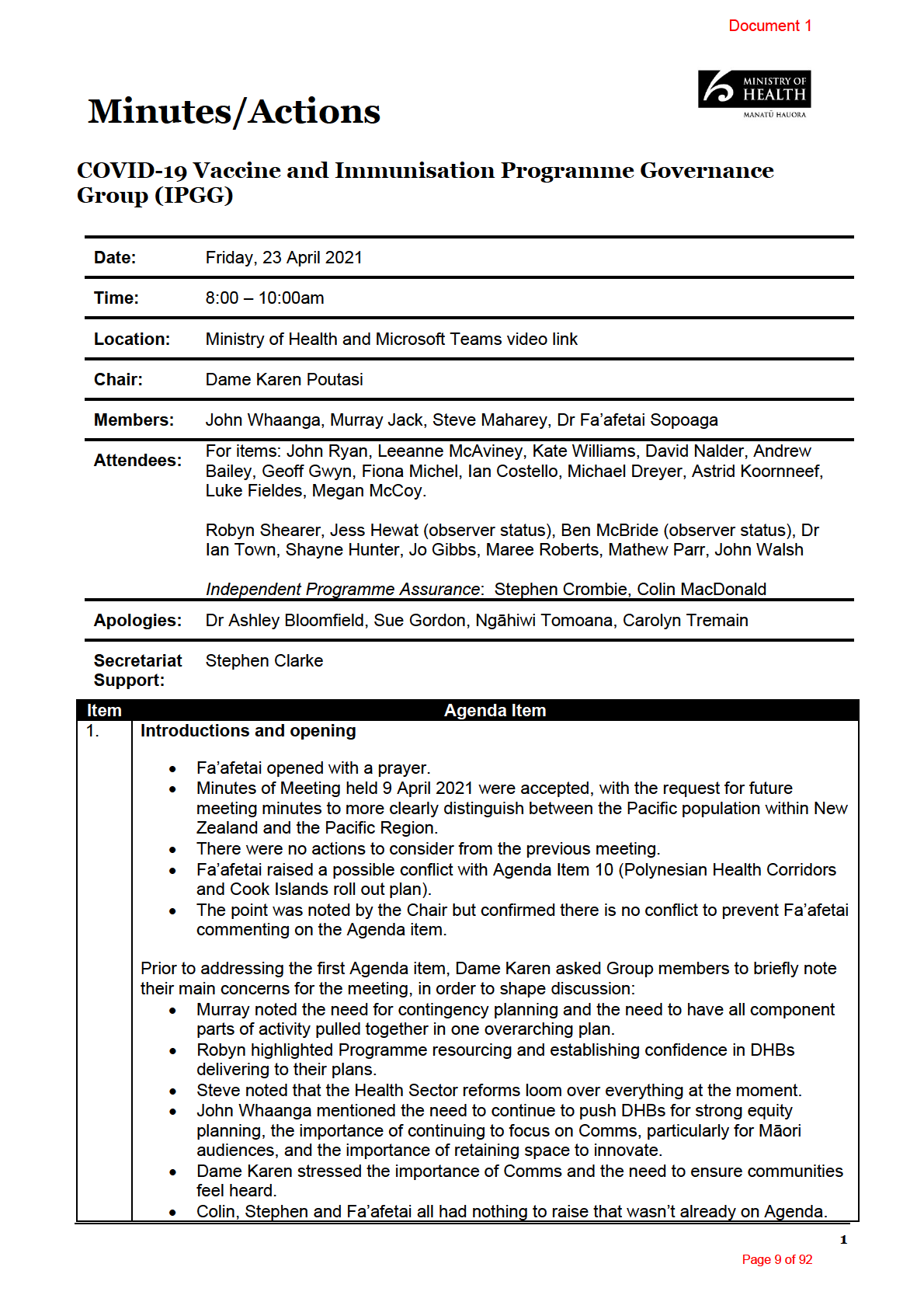
1982
ACT
INFORMATION
OFFICIAL
THE
UNDER
RELEASED
Document 1
2
Office of Auditor General update on performance audit and draft report (John Ryan,
Leanne McAviney, Kate Williams)
Dame Karen noted that the draft Report had been read in confidence by Group.
John Ryan provided high-level overview of report and thanked Programme for its engagement
in the process
• The focus of the report is mainly on determining whether the Programme is ready for
big scale-up, and he wants to ensure report is useful as well as balanced and fair.
• The three areas he would suggest the Group focuses on in its governance role are
workforce, logistics, and communications.
Group Discussion
• Leanne noted that Programme transparency wil be key in managing expectations and
stressed importance of the programme being clear with the public around risks
1982
• Jo noted that good progress is being made to respond to draft report within OAG’s
requested timeframes, as well as to provide additional written information to ensure
full context is provided.
ACT
• Steve stressed the importance of the programme having communication prepared for
when the report is tabled
• John Ryan suggested Ministry may wish to publish a report at the same time as final
report in order to show progress on different aspects.
3
Programme status and risk summary (David Nalder and Mat Parr)
Paper considered – CVIP Risk Summary 23 April 2021
a) Programme status and risk summary
INFORMATION
• David noted that his top priority for next two weeks wil be responding to the OAG
report, and wil be focusing on making sure there is a direct link between risk
measures and our readiness to scale in July.
• Jo noted that the wider health sector reform would present risks for the Programme,
notably around DHBs conforming with Accountability Framework as time goes on, and
around the recruitment of Programme staff int
OFFICIAL o other activities.
Group Discussion
• Fa’afetai noted the importanc
THE e of limiting vaccine wastage
• Jo said that root cause analysis was ongoing of the CCDHB wastage incident and that
the message has been passed that not wasting stock is top priority (above
Sequencing Framework)
• Murray noted that the wastage risk wil increase when Programme scales up so
Planning and Logisti
UNDER cs teams wil need to think about this when doing design work
• Mat noted that higher wastage forecasts from 30 June onwards are built into the
model
• Stephen discussed the importance of the relationship between the Risk Register, the
Milestone Plan and Programme’s overall readiness to scale, and the need for these
documents to reflect our confidence in delivering to scale
• Murray stressed the need to land the overall programme plan as this would allow risk
register just to serve an assurance function
RELEASED
4
Programme progress reporting (Mat Parr, Andrew Bailey)
Paper considered – Milestone and progress reporting 20 April 2021
Mat introduced topic by noting that the team has been working through DHB SRO forum to
make the milestone view a Programme wide document rather than just Ministry
• Mat also noted that there is stil work to be done to ensure equity information is
reflected in the milestone view
2
Page 10 of 92
Document 1
Andrew drew attention to Slide 4 which shows key deliverables for different population
milestones. This should help Programme monitor and have confidence in each of those as
the go-live date approaches.
Group Discussion
• Dame Karen noted the importance for milestone view to also pick up on when certain
requirements would no longer be needed
• Robyn sought clarification regarding the overarching plan and how that would fit
alongside this document
• Jo proposed to do a standup at next Governance Group meeting to go into the finer
details of the plan and show how everything links together
• Jo said that Programme has commit ed to vaccine Ministers that it will publish in early
June the DHB plans for July onwards
Action 1: Standup to be organised for next Governance Group meeting to enter into
1982
finer details of Programme planning
5
Draft Accountability and Planning Framework (Jo Gibbs, Geoff Gwynn) ACT
Paper considered - Planning and Accountability Framework
Jo updated the Group on the status of the Planning and Accountability Framework
• The draft has been prepared in conjunction with DHB SROs and has been signed off
in principle with all CEs. This draft wil go out to DHBs next week
• Aim is to have clear accountability of delivery of the programme, as well as of the
legacy items such as non-regulated workforce and connections with Pacific, Māori and
disability providers.
• Underneath this Framework there wil be two detailed documents. One looking at the
pathway to vaccination for consumers and accountabilities of that through
INFORMATION all
providers, and a second looking at the governance framework and giving clear details
of responsibilities at every different level.
• There is also a production plan which has been developed and gone out in draft this
week to DHB SROs.
Group Discussion
OFFICIAL
• Shayne asked to see more in the framework around accountability for implementation
and operational support around technology systems
THE
6.
Operations update: this week and next week (Jo Gibbs, Astrid Koornneef)
Paper considered – COVID-19 Vaccination Daily Report 21 April 2021
Paper considered - Extract from MoH website 21 April delivery against DHB plans
Jo gave update on DHB performance against plans
UNDER
• The first weekly performance was published on Wednesday and overall have met the
planned figures, although there is big variability between performance across DHBs
• There have been conversations with the CEs of the four DHBs who were at less than
90% of target to see what support could be offered
• This wil be particularly important as each of these DHBs have high Māori populations
so there are equity considerations that need to be addressed
• There has been an offer of Comms support and teams to visit the DHBs, and this of er
may st
RELEASED art to be looked at as a requirement if targets continue to not be met
• Robyn said that during a call with DHB CEs last week she had informed them to
develop a clear plan on service impacts, if necessary, in order to deliver vaccine
programme
• Murray noted that jumping on performance issues quickly would be important, and
recommended pushing support in sooner rather than later where issues are being
seen
3
Page 11 of 92
Document 1
7.
Leading and lagging indicator development (Luke)
Luke offered update on development of leading indicators:
• The team is starting to have sufficient data to be able to move into more predictive
analytical work
• Major areas of forecasting they are currently looking at include: Vaccine usage per
vial, workforce availability, number of sites online, vaccine uptake, adverse events,
and user experience.
• It should be possible to present back to Governance Group on progress of this work
within next few weeks
• Murray noted that a crucial thing to forecast wil be inventory against plan, including a
metric to show what proportion of current inventory is already ‘commit ed’ for people
receiving second dose
Action 2: Further update on development of leading indicators for next Governance
1982
Group meeting
8
Update on plan to scale
ACT
a) Workforce (Fiona Michel)
Paper considered – Vaccinator Workforce Plan_V3
Fiona gave overview on workforce workstream
• The document provided gives an overview of the different sources where workforce is
being drawn from
• The training process has been streamlined by lifting the requirement for eligible
trainees to register first with DHBs
• A primary focus of the team is partnering with IMAC on developing the
INFORMATION non-regulated
workforce training programme
• Team is also working on contingency planning in case there are issues with workforce
• Conversations are ongoing with a number of occupational health providers, although
in some areas these providers are asking for a price which is not reasonable
Group Discussion
OFFICIAL
• In response to a question from Fa’afetai, Fiona noted there had been work done with
Deans from several universities to engage health students in the workforce
• Jo noted that DHBs are already being encouraged to develop the pool of non-
THE
regulated staff so that when training is live they wil be ready
• In response to a question from Dame Karen, Fiona acknowledged that a number of
things needed to be done to enable the non-regulated workforce to become active in
the Programme, but that she was confident this avenue was stil viable
• Dame Karen asked for an update at next Governance Group meeting to provide
UNDER
assurance around the feasibility of this workforce
Action 3: Update to be provided on non-regulated workforce at next Governance Group
meeting
b) Logistics (Ian Costello)
Paper considered - 210419_Logistics Update
RELEASED
Ian pointed to two key elements within the document provided to the group:
• Update on the new inventory portal going live on 3 May which wil make it easier to
accommodate unplanned walk-ups
• The process for setting up a second national hub in Christchurch, which is a crucial
supply contingency
c) National booking systems (Michael)
Michael provided an update on the National booking system
4
Page 12 of 92
Document 1
• Things are on track for two pilot sites to be live from April 27th, which wil be expanded
during May
• By June/July more advanced functionality like invitations should go live
• The key for the success of booking system wil be getting the operational model in
place that is required to support the technological side of the system
• Shayne suggested that there should be a standing item for Operational aspects
moving forward
• Dame Karen agreed with this and suggested it be added as an early Agenda item for
future meetings
9.
Communications and engagement (John Walsh)
Paper considered – Communications update 21 April 2021
John Walsh provided overview of Comms situation
1982
• Campaign started last Friday with focus on getting basic factual information out
• After ANZAC weekend the emotive layer of campaign wil start to roll out nationally,
except for in Counties Manukau where more specific information wil be used
ACT
• Comms targeting Māori audience wil be done at national level through ensuring
representation within material, through a targeted campaign from TPK, and through
local campaigns run at iwi/hapu level
• There wil be weekly attitudes surveys starting from next week to try to capture and
monitor people’s intention to be vaccinated
• There have also been two formal communications with primary care in last week
Group Discussion
• Jo noted there are meetings started with GPs and primary care with good feedback on
INFORMATION
the way things are progressing.
• Mat added that the full funding model has been shared with DHBs, signed off by DHB
CEs and communicated to leadership of primary care, GP and pharmacy groups.
• In response to a question from Colin, John Walsh said he was confident the team
would have appropriate resourcing to respond to any strong anti-vax response to
campaign material.
OFFICIAL
10
Polynesian Health Corridors and Cook Islands roll out plan (Megan McCoy)
Paper considered - Polynesia vaccine roll-out for steering group 19 April
THE
Megan gave update on planning for Polynesian vaccine rollout
• Work is progressing towards a mid-May rollout for Cook Islands, although there is a lot
of work stil to be done, notably around assurance for Ministry and pharmaceutical
UNDER
companies on donation.
• The work with Cook Islands wil inform the approach with other countries.
• There wil be a meeting next week with representatives from Nuie then with other
countries over following weeks.
Group Discussion
• Jo stressed the importance of being transparent around the fact that provision for
RELEASED
Cook Islands wil come out of New Zealand’s current supply.
• Fa’afetai reminded the Group of the importance of being sensitive in communication
with these nations, bearing in mind that despite New Zealand being a friend to Pacific
nations, it was also at one time a colonial power.
• Megan noted that the newness of COVID vaccines means that New Zealand wil have
to work in a more hands on manner than on previous occasions where vaccine
support has been offered. Finding the right balance for this wil be crucial.
5
Page 13 of 92
Document 1
Suggestion was made by Dame Karen for Polynesian health corridor to be rediscussed at
next meeting and moved towards the beginning of the agenda.
11.
Real Time Assurance Leads Update (Colin MacDonald and Stephen Crombie)
Colin suggested work being done to better understand the demand side of workforce, as work
until now has focused on supply side. He also suggested it would be useful for Comms team
to look closely at the need for coherent but separate messaging between Ministry and DHBs,
in order to ensure local level information is relevant.
Stephen stressed the importance of adequately resourcing the work on Accountability 1982
Framework, and the need to align the timing of delivery design with technology side.
12.
Meeting close
ACT
• Fa’afetai closed with a prayer.
INFORMATION
OFFICIAL
THE
UNDER
RELEASED
6
Page 14 of 92
Document 1
Out of scope
1982
ACT
INFORMATION
OFFICIAL
THE
UNDER
RELEASED
7
Page 15 of 92
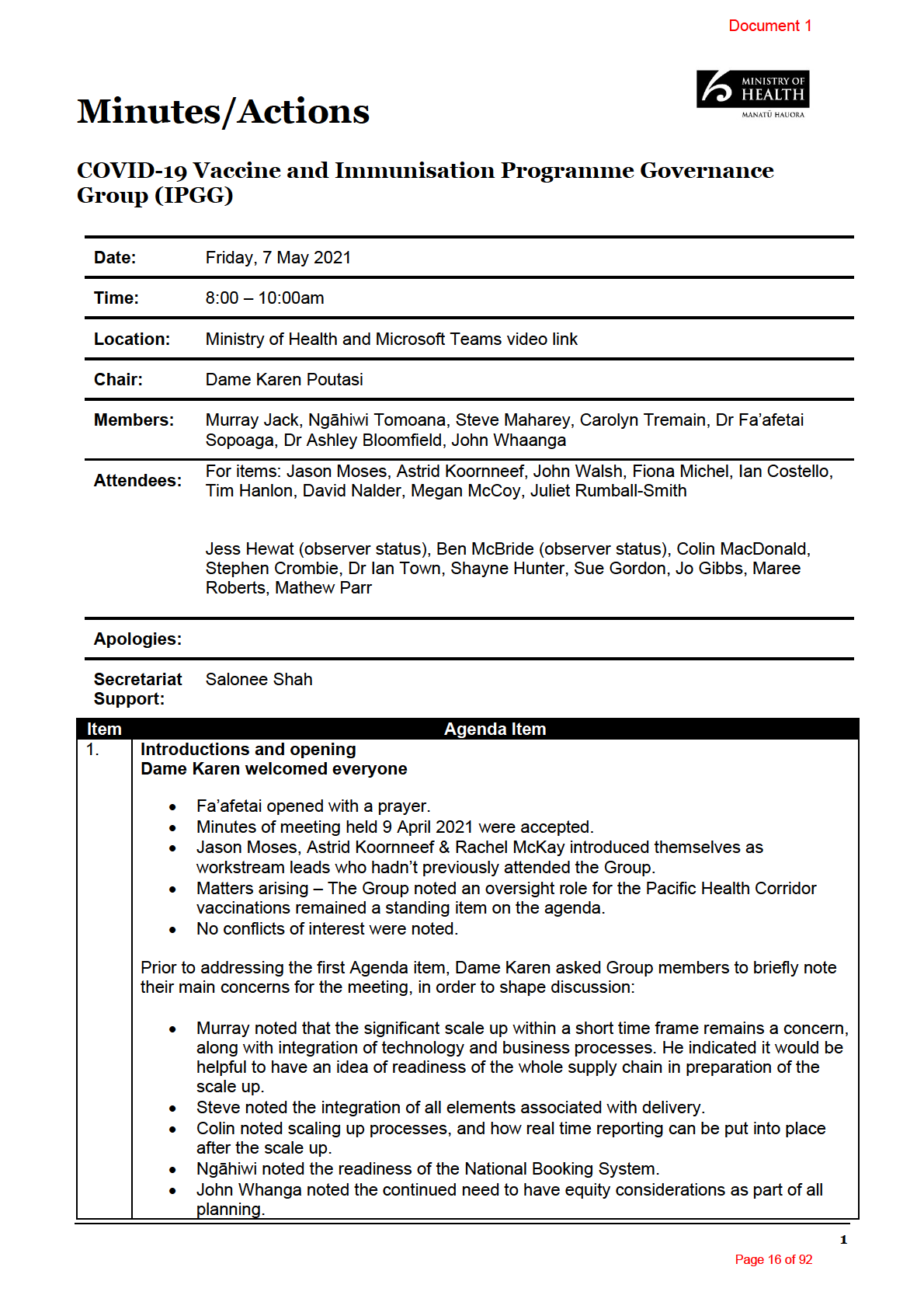
1982
ACT
INFORMATION
OFFICIAL
THE
UNDER
RELEASED
Document 1
• Fa’afetai noted her interest was in pharmacovigilance, particularly whether the current
system allowed for the extraction of data in a way that can be used to provide
meaningful insights
• Dame Karen noted her questions are mainly in regard to the scaling up in the primary
care area- and implications on the overall project
2
Operation Update
Paper considered – COVID-19 Immunisation Programme Update 2 May
Paper considered – Daily Covid-19 Vaccine and Immunisation Programme Report (as at
23:59)
Jo Gibbs provided an overall programme update.
• Jo noted the programme target was on track to exceed targets again this week and
that currently, the Programme was 3% over target.
• Jo informed the Group on details around ongoing programme targets and risks,
1982
particularly around delivery, and timelines.
• Jo noted a team was in Northland this week, to provide support to the DHB.
• Jo confirmed a response from the Programme to the draft Office of the Auditor
ACT
General’s report was provided and details on when the report was going to be
published have not yet been confirmed.
• The Programme sent CEs and SROs the accountability framework and planning
packs. The planning packs are to enable DHB’s to create a detailed plan for July -
October and a more high-level plan for October – December.
• Jo stressed the importance of keeping the current programme team together
considering all the changes and announcements within the Health Sector.
• Ashley noted risks associated with the resource constraint at a senior level and that
any such risks should be flagged early.
• Luke presented on the operations dashboard. The Group discussed ar
INFORMATION eas of the
dashboard that were insight and area where they wanted further information
• Mat explained the data on the operations dashboard and how the data figured into the
planning.
• Colin acknowledged that this is the sort of reporting would help monitor the
programme as it scales up in the upcoming months.
• Colin noted as the programme continued, ass
OFFICIAL umption testing and adapting if required
is important to programme success. He suggested highlighting success measures and
tracking goals and evaluating these on a regular basis.
THE
•
Action 1: Update to be provided at next Governance Group meeting on ratio
between walk ups versus bookings at vaccination sites.
• There was discussion on whether the model should “reserve” vaccines as second
dose. It was noted, t
UNDER here are levers that can be used if there is a change in situation in
regard to vaccine supply.
• The group discussed different areas of messaging through the communications plan.
Providing clear guidance to public on vaccine safety and delivery required some
thought.
RELEASED
2
Page 17 of 92
Document 1
3
Programme progress report and walk through of workstreams (Jo Gibbs)
Service Design (Mat Parr)
• Mat provided an overview of the different kinds of service models that would be in
place over the course of the vaccination programme, some of which are:
o Mass vaccination sites
o Community health hubs
o Aged care residential model
o Workplace model
o Occupational health model and,
o School based model.
• Project milestones were noted.
• Programme team provided clarity to the group on questions around different service
models and when and how there were going to be used.
• Dame Karen stressed the importance of the integration of the logistics and delivery
1982
systems as much as possible.
• Rachel McKay noted some of the National contracts have largely been established
through occupational health providers.
ACT
Equity (Jason Moses)
• Jason noted the strong equity focus within the individual workstreams, and overall, in
the programme, but there was room for more work in this area.
• Jason noted that current data suggests a lower uptake of the vaccine in the Māori,
Pacific and disability community. He indicated that low up take may reflect some
inequities in the healthcare workforce, which is a priority currently in the sequencing
framework, and once vaccination of group 2, 3 & 4 begins, we could see an increase
in uptake.
INFORMATION
• Jason highlighted that equity in the workforce is an important component along with
other work to meet our Te Tiriti o Waitangi obligations.
• Areas of focus in the equity workstream service design including meeting with DHBs
to ascertain their plans for Māori, Pacific and disability populations.
• Jason noted there are a range of actions in the pipeline to address equity within the
programme such as targeted communications, working with Maori and Pacific health
OFFICIAL
providers, and establishing vaccine support roles who will work in communities to
coordinate services around equity and to spread key messages.
THE
Group discussion
• Dame Karen asked about how the Kaiāwhina workforce is being utilised as part of the
programme.
• Jason noted that discussions were on going on targets for Māori and visibility of these.
• Colin noted that additional support should be available to Jason as required to enable
UNDER
equity targets to be met as the programme continues.
• The content of messaging to the communities was discussed, and Jason noted that it
should be clear that anyone that would like to get vaccinated would have services
available to do so in an environment that they felt most safe and comfortable in.
Operations (deep dive into Booking System) Astrid Koornneef
Michael Dreyer / Astrid provided an update on the National booking system
RELEASED
• Michael provided an update on changes in technology and talked through the new
features that wil available in the CIR.
• From the end of May DHBs wil be online with the booking system.
• An additional feature to go live in June wil be an automated targeted invitation
capability.
• Astrid discussed the operating model, key highlights that her team have been focusing
on, and how accountability wil feature at each step of service delivery.
3
Page 18 of 92
Document 1
• In response to a question from Dame Karen, it was noted that although ful integration
between new systems and DHB systems would not be possible, a range of options wil
be created to ensure, systems are integrated to highest extent.
• Astrid noted that as the model is further developed, it will be possible to monitor the
pathway of an individual on their vaccine journey and the aim was for all DHBs to be
onboarded by end of May and all sites across the country to be using the system by
the end of June.
• Astrid further noted that regional teams wil be stood up to support the onboarding,
training and support the DHBs through the roll out. Non DHB providers wil be targeted
and onboarded through DHBs.
• John Walsh noted that there wil be comms to inform the public that they can go to
organisations they are comfortable with who can help with the booking process.
• A member of the Technology team provided a live demonstration of how the booking
system works.
• Juliet provided an overview of the clinical workstream noting the main areas of work
1982
as internal quality and safety protocols and how the Ministry can support quality on a
national level through the national quality assurance framework.
ACT
Comms and Engagement (John Walsh)
Paper considered –Comms update 3 May
John Walsh provided an updated on the communication plan. He noted key areas that the
communications strategy wil be focusing on.
• Vaccine supply constraint until the end of June.
• Communications in regard to the launch of the booking system.
• More tailored communications across DHBs to correspond to the part of the
INFORMATION
sequencing framework they are targeting.
Group Discussion
• Carolyn noted that there is potential to use employers to create group bookings at
individual work sites and there are channels already available to be able to do this.
• Carolyn asked if there was a communications strategy in place in the event that the
OFFICIAL
Booking System gets overloaded to which John Walsh replied that expectation
management is a key part of planning for such events.
THE
Sector engagement and Workforce (deep dive) Fiona Michel
Paper considered – Sector engagement, workforce and welfare workstream: Covid-19
Vaccinator Assistant training programme.
Fiona provided an overview
UNDER on workforce workstream.
• Fiona noted that there are three key areas the workstream is currently focused on:
workforce pipeline, training of the workforce to meet requirements, and making sure
we have planned that we have the right people in the right places.
• Workforce team is making concerted ef ort to increase proportion of Māori and
Pasifika within workforce
• As of last week, qualified individuals are now able to register directly with IMAC for
training without passing via a DHB
RELEASED
• The Programmes Steering Group have supported the decision for a regulatory change
to allow vaccinator assistants to be added to the programme workforce.
• A paper wil be submitted to the Minister on 10 May 2021 for approval for a regulatory
change, followed by a Cabinet paper, with Cabinet decision expected on 24 May
2021.
• Pilot training course is scheduled for 13 May with a Māori provider based in Auckland,
with a pilot online training course planned the week after.
• Fiona noted this course wil help provide required workforce for DHB peak needs
4
Page 19 of 92
Document 1
Group Discussion
• In response to a question from Dame Karen, Mat noted that engagement was ongoing
with big business, with a specific Business Engagement Lead also being brought in
• Fiona noted the number of trained vaccinators does not confirm their availability to
vaccinate, which the programme is aware of and are working to have more workforce
capability available.
• Colin noted the risk associated with vaccinator assistants requiring supervision, with
Fiona and Jo noting work being done in Programme to mitigate this risk.
• Jo noted that the strike planned by the New Zealand Nurses Union is a risk the
programme wil continue to monitor.
Logistics (Ian Costello)
Ian provided an update to the Group on the logistics workstream.
• the workstream focus was the distribution model, mainly national and regional bulk
1982
storage, storage capacity and wastage.
• the second hub in Christchurch wil aide South Island distribution needs.
• further work has commenced on piloting DHB hubs and a more regional distribution
ACT
network.
• Risks are being managed partially via an incremental phase-in of new systems
Group Discussion
• Effort is being made to reduce the pressure on the digital workstream, notably through
bringing in additional operational support to focus on day-to-day queries, and pausing
the development of two Distribution systems
• It was noted that there are additional levers than can be pulled to meet deadlines if
required, including through pulling people in from other Directorates.
INFORMATION
Post Event (Tim Hanlon)
Tim provided an update to the Group on the Post Event workstream.
• Tim noted three work packages as part of the Post Event workstream as passive
monitoring, active monitoring and pharmacovigilance
• Tim noted that the ability of CARM to scale w
OFFICIAL as a challenge, although steps put in
place via CIR and E-Covid form have helped address this, particularly the auto-triage
functionality
• Tim noted the benefit of acti
THE ve monitoring around building public confidence, with
• programmes Steering Group having made an in-principle decision to progress to
active monitoring.
• Tim noted work being done with Medsafe on a new database for pharmacovigilance,
with the hope this wil be active within next couple months.
UNDER
4
Risk Summary (David Nalder)
Paper considered - Programme Risk and Issue report
David provided an update on the Risk Report noting that the reports have been simplified to
highlight the top five risks as identified by Programme Leadership Group.
RELEASED
Group Discussion
• Murray noted that a continued assessment of the top five risks, to show whether they
were staying the same, worsening or getting better should be monitored.
• Ashley noted mitigation of risks should be further considered.
• The Group discussed the risks associated with support provided to the Realm and
other Polynesian countries.
• Mat noted that while New Zealand wil be supporting delivery, countries using
AstraZeneca would be responsible for the approval decisions around that.
5
Page 20 of 92
Document 1
5
Polynesian Health Corridor and Cook Islands roll out plan (Megan McCoy)
Paper considered – Cook Islands Weekly Status Report
Megan provided an update on the vaccine roll out in the Polynesian Countries.
• Megan noted work is ongoing to train vaccinators in the Cook Islands.
• Megan noted that Niue wil be the next cab of the ranks.
• Sequencing of other countries that New Zealand wil support for a roll out is on-going
Group Discussion
• Ashley noted there have been discussions with Ministers on the quantity that would be
supplied to the Cook Islands.
• Tai noted that the Programme would require to have the processes around
Pharmacovigilance live in New Zealand before it is offered outside the country.
6.
Real time assurance leads update (Colin MacDonald, Stephen Crombie)
1982
Stephen noted programme planning and design is now reflecting well the complexity of the
programme.
7.
Summary of meeting and close (Chair)
ACT
• Murray has highlighted the challenge of having all systems integrated in time for the
July scale up, noting that many of the systems that will be used for mass rol out are
not used for current Groups. He also noted the challenge of managing supply and
demand once the Booking System goes live
• Ashley noted that communication of how the sequencing framework wil work wil be
important once vaccinations for group 3 & 4 begin.
• Shayne noted the importance of Programme identifying top priorities in order to focus
attention on key issues, including what manual processes may be dif icult to scale up.
INFORMATION
• Ngāhiwi noted Equity funding past vaccination and immunisation should be
considered in forward planning.
12.
Meeting close
Ngāhiwi closed with a prayer.
OFFICIAL
THE
UNDER
RELEASED
6
Page 21 of 92
Document 1
ACTION TRACKER
NO.
ACTION
OWNER
STATUS – DATE (Due or closed)
COMMENTS
210115 -02
Consider if this Governance Group should have
MoH and MFAT
In progress
Stil under consideration
1982
a continued role overseeing the Pacific Health
Corridors support for Vaccine
210129-01
For MoH to consider the ‘readiness’ process that Mathew Parr
In progress
Accountability framework with DHBs, wil be signed off as
ACT
it wil seek to put in place with leads to ensure
part of DHB acceptance of plans
accountability
210423-02
Further update on development of leading
Jo Gibbs
In progress
Draft on agenda 7 May
indicators for next Governance Group meeting
Luke Fieldes
210423-03
Update to be provided on non-regulated
Jo Gibbs
On agenda 7 May
Complete
workforce at next Governance Group meeting
Fiona Michel
210507-01
Update to be provided at next Governance
Jo Gibbs
On agenda 21 May
INFORMATION
Group meeting on ratio between walk ups
Luke Fieldes
versus bookings at vaccination sites
OFFICIAL
THE
UNDER
RELEASED
7
Page 22 of 92
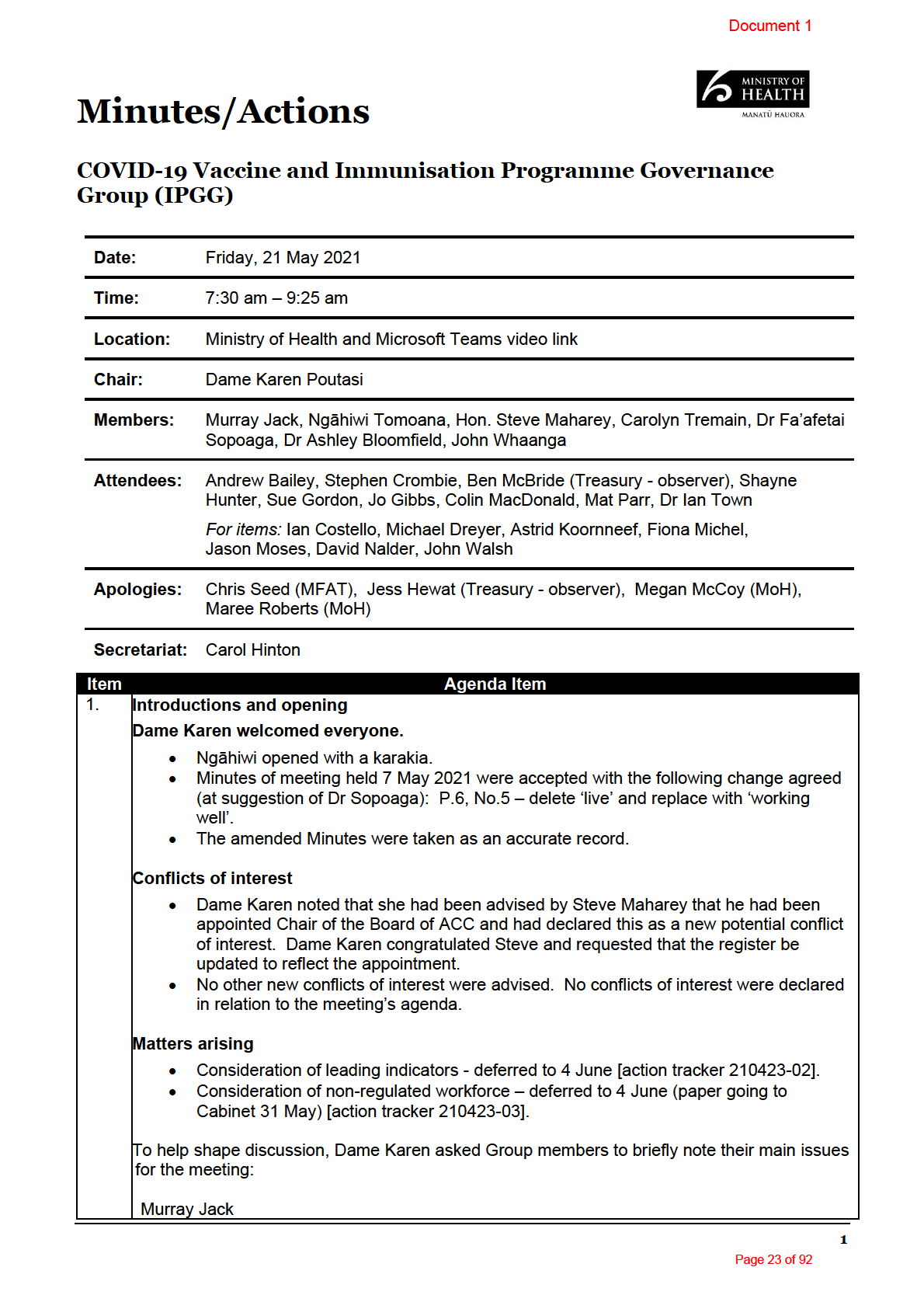
1982
ACT
INFORMATION
OFFICIAL
THE
UNDER
RELEASED
Document 1
• Sequencing framework and how it is executed – he noted the importance of clarity in
the early stages.
• Booking system – he sought clarification as to whether this would be mandatory,
noting this created a risk of a single point of failure, with subsequent impact on supply
and demand.
• Technology failures, including those relating to workforce.
Hon Steve Maharey
• Agreed with the issues raised by Murray.
• DHBs performance reliability for relatively even rollout noting Waikato DHB situation.
• Evenness of supply – planning and implementation.
• The consumer experience – noted he had not heard a lot about this but it was of
increasing importance.
• Steve also noted that overall commentary surrounding release of the final version of
the Auditor-General’s report sounded positive, with other perspectives not appearing
1982
to gain traction.
Carolyn Tremain
ACT
• Sequencing framework.
• Timelines – relating to core system and contingency planning.
• Anti-vaccination/misinformation.
Dr Fa’afetai Sopoaga
• Northland rollout – sequencing and equity focus.
• Managing vaccination to minimise wastage.
Dr Ashley Bloomfield
INFORMATION
• Wil welcome feedback from the Group around contingency, and whether the booking
system should be mandatory for all, or mandatory in certain settings only.
John Whaanga
• Agreed with points raised by others, adding that a strong equity focus was required
across all workstreams. We must make sure we push equity in the same way as we
are pushing sequencing. OFFICIAL
• Ensuring balance in rollout – do not leave ‘harder to reach people’ until last.
Colin MacDonald
THE
• Information flow at scale – how it works – ensuring we have capacity.
• Driving equity – Colin noted he expected this to be more visible in next set of DHB
plans due shortly but noted MoH may need to work further with some DHBs).
Stephen Crombie
UNDER
• Demand management and implementation approach in early stages of scale.
RELEASED
2
Page 24 of 92
Document 1
2.
Operations Update (Jo Gibbs)
Paper 3 considered – COVID-19 Immunisation Programme Update - 16 May
Jo Gibbs provided an overall programme update.
• New Zealand achieved half a mil ion vaccinations the day prior to the meeting, on
20 May. Now at 505,800. The Ministry is providing some media comms re this
achievement.
• DHBs continue to move steadily. The main concern is managing supply and demand
until we have volume supply from Pfizer. MoH is aware that Ministers prefer that we
endeavour to not cap DHB delivery but this has to be balanced against supply.
• The EMEA has approved the storage of Pfizer vaccine in Europe at 2-8oC for 21 days
(up from 5 days). This means storage is more aligned with other vaccines. Pfizer has
just applied to Medsafe for approval to use in New Zealand and Medsafe wil consider
urgently.
• Wastage is tracking at about 2%. Al DHBs and national providers have contingency
1982
plans to ensure effective use their vaccine (however, these plans were made before
the EMEA announcement).
• MoH has worked with all DHBs re their respective regional rollouts. Northland
ACT
sequencing issues now largely addressed. Canterbury has begun rural vaccination
earlier than planned. MoH wil provide more specific assistance to mitigate these
types of issues for Group 4 rollout.
Ashley Bloomfield noted that:
• If approved for application in NZ, the Pfizer storage changes will have considerable
implications for rollout.
• In terms of prioritisation to avoid wastage of vaccines, MoH has reiterated to DHBs
that they must have formal plans that focus on equity.
• Group 3 is about 1.7 mil ion people (or 40% of the eligible population) and
INFORMATION the
invitation strategy and associated messaging is being carefully thought through.
• A recently commissioned survey shows some quite big shifts from ‘hesitancy’ to
‘acceptance’ by Māori and Pasifika.
Piloting for rol out (Jo Gibbs, Mat Parr, Andrew Bailey)
Paper 4 considered: First Desktop Exercise – Primary care -19 May 2021
OFFICIAL
• Ashley Bloomfield noted that currently, there are 800 locations available for rollout
vaccination services from July 2021, and one-third of these are GPs.
THE
• A desktop exercise of the operating model to support large scale, national vaccination
rollout (from a primary care perspective) was held on 19 May. This was extremely
beneficial and identified key focus areas as:
o How information flows and technologies integrate to support delivery of
vaccination services,
UNDER
o Prioritising equitable access through the invitation strategy,
o Extent to which use of the national booking system is mandatory,
o Support for implementation of technology for primary care providers,
o Access to trained vaccinator workforce (aligned to rollout requirements).
• Dame Karen endorsed that care must be taken to ensure the booking system does not
prevent people from accessing vaccination (e.g. if they do not have access to or
cannot operate technology). Unplanned demand wil arise and need to be met.
• Michael
RELEASED Dreyer advised that GP access to CIR (the register) has been IT enabled and
wil be load tested. However, use of the booking system is more complex as there are
three ‘tiers’ of GP to be enabled which were not considered in the initial design.
• Jo Gibbs advised that no decisions had been made as to the extent to which the
booking system wil or wil not be mandatory. Likely to recommend a mixed model
and put recommendations to the Steering Group.
• Shayne Hunter noted the importance of quality data – understanding what data we
need and ensuring we have it, as data is the basis of planning and decision-making.
3
Page 25 of 92
Document 1
He saw data collection as a priority focus over having total systems integration from
Day 1. Dame Karen supported that data wil highlight if integration is required.
• Murray Jack endorsed the point raised earlier by Ashley Bloomfield, noting that the
proposed changes to storage of the Pfizer vaccine strengthens the opportunity to use
the GP network.
• Colin MacDonald agreed with the focus on ensuring primary care systems are
operating smoothly to support effective rollout 1 July. He also noted the significant
change in dynamics through the Pfizer announcement but cautioned against putting
too much ef ort into expanding the model immediately. He saw related changes as a
‘back end of year’ activity.
• Carolyn Tremain noted that the wider political environment could become more
challenging as Australia progresses its rollout, and relativity comparisons with
New Zealand rollout start to be made. Comms that clearly set out the rationale for the
New Zealand approach wil be critical.
• Mat Parr confirmed that a paper wil be developed that covers the strategic 1982
implications for the Pfizer announcement for the CVIP rollout including sequencing,
storage, wastage etc. It was hoped to put this paper to the Steering Group on 25 May.
• Carolyn Tremain agreed that the implications of the EMEA announcement are
ACT
complex and much broader than just ‘storage’. She endorsed wastage and
implications for the workforce as matters she would envisage would be covered in a
strategically focussed paper. Carolyn also noted that the rollout model would need to
change later in 2021.
• Mat Parr advised that five more similar exercises are planned by end June.
• Dame Karen endorsed the importance being placed on testing, particularly scale
testing.
Noted: a paper is being developed which discusses strategic implications of the Pfizer
storage announcement for the CVIP rollout. This will be considered by t
INFORMATION
he Steering
Group on 25 May.
Communications and Engagement (John Walsh)
Papers 7a – 7e considered
• Focussing on Group 3 launch – officially this is end May but will be staged across
OFFICIAL
DHBs. There will be no ‘grand launch’, however, MoH has appointed account
managers and wil be providing targeted and consistent comms to help each DHB
manage community expectations and streamline demand.
THE
• Comms – recognise the differing media habits of those aged over 65 years and make
heavy use of press and radio, though the latter is harder to target geographically.
s 9(2)(g)(i)
• Members emphasised the importance of a positive consumer experience. They
acknowledged the challenges posed by a phased implementation, but cautioned that
UNDER
the
“vaccination has started in your region - don’t do anything yet – we will call you”
approach risked frustrating those keen to receive their vaccination. Ashley Bloomfield
agreed that it was also important to reassure groups who were waiting that the current
measures in place around the country wil continue to keep unvaccinated people safe.
• Al DHBs are now ‘on board’ with planning, though not all were early adopters. DHB
plans are signed off by the SRO as a minimum.
For noting by
RELEASED
CVIP: Remain mindful of the need to understand the consumer journey
and of the importance of a positive consumer vaccination experience.
•
Managing misinformation
• John Walsh advised that we continually release accurate information. This is changed
in response to analysis of concerns and misinformation from the previous week. Use
consistent themes – safety, ef icacy, approvals process.
• We have ability to target the geographic hotspots of misinformation. Targeted drops
recently in Nelson/Marlborough.
4
Page 26 of 92
Document 1
• Carolyn Tremain asked if we continued to promote ‘Unite against COVID-19’ and the
Ministry as the sources of authoritative information, and John agreed this was an area
that can be strengthened.
•
Māori, Pacific and Asian community engagement
• John Walsh noted that MoH is supporting Te Puni Kōkiri and the Ministry for Pacific
Peoples with the engagement campaigns – both funding and content.
• MoH works closely with the Iwi Communications Collective to support work with iwi
and hapū.
• MoH has just agreed funding for Maori comms providers
(see Jason Moses’ key
points below).
• In response to a question from Steve Maharey, John Walsh advised that engagement
with Asian communities needed strengthening. However, following appointment of a
dedicated resource for this work, he now has a draft engagement plan under
consideration.
1982
Focus on equity (Jason Moses)
• Jason Moses said the current strong focus is on the development of DHB engagement
ACT
plans for Group 3, and ensuring that DHBs were partnering to achieve equity
outcomes. The equity focus needed to be ‘end to end’ across service commissioning
and delivery. The Ministry has allocated every DHB a regional account manager to
ensure support is tailored and appropriate.
• Assessment of the 57 applications to the Ministry’s $2 million Māori Communications
Fund has been completed. The fund was well over-subscribed. Distribution of funds
will begin shortly and will help organisations to establish roles or undertake
communications specifically tailored to Iwi and Māori.
• The Ministry is considering whether it can provide some additional funding for
communications to help address regional ‘reach’ across Māori, Pasifika a
INFORMATION nd disability
communities.
• At least three marae sites (Manurewa marae, Waipareira Trust in Henderson, and
Murihiku marae in Invercargil ) are gearing up for vaccination on a larger scale, with
Manurewa marae able to vaccinate up to 300 people per day.
Group discussion
OFFICIAL
• In response to a question from Murray Jack, Jason confirmed that DHB plans
contained both equity narrative and volumes/targets.
• Mat Parr clarified that these DHB plans wil all feed into a quality/success framework
THE
to be considered by Cabinet in June. The framework wil have a strong pro equity
focus.
• John Whaanga said there is significant leadership re COVID-19 vaccination being
demonstrated in the Waikato. He also noted the importance of the whole customer
journey which is much wider than just the injection for example, seating in waiting
UNDER
areas, pronouncing names correctly.
• John also noted he understood that some implementation matters must be led by the
centre, but having a single focus on COVID-19 could mean that wider opportunities to
improve service delivery were missed. Some flexibility was essential.
• Dame Karen acknowledged this and endorsed the importance of the Kaiāwhina
workforce as being part of the desired wider growth/legacy of implementation.
RELEASED
Operations (Booking System) Astrid Koornneef
Astrid provided an update on the National booking system
• The booking system is being tested in three regions, including through website and
phone booking. Some issues experienced in Kaikōura have successfully been
addressed at national level. Pilot wil be completed in the week commencing 24 May.
• Next step is to get all DHBs online with the system.
5
Page 27 of 92
Document 1
Group discussion
• In response to a question from Stephen Crombie re assurance of DHB capability,
Astrid advised that DHB scaling plans must show both the experience and capability
to implement to plan.
• In response to a question from John Whaanga, Astrid advised that the difference in
pilot experiences of Kaikōura and Auckland was due to there having been no prior
relationship with the Kaikōura provider.
Sector engagement and Workforce (Fiona Michel)
Fiona provided an overview on workforce developments:
• There are 5,614 trained vaccinators. 2,054 are active or have been active in the CVIP
programme.
• 9.6% of vaccinators are Māori and 2.9% are Pasifika – stable over the past fortnight.
• We received 105 submissions on the proposed regulatory change to allow for 1982
establishment of a COVID-19 vaccinator. Māori and Disability advocates supportive.
NZNO has concerns and MoH is meeting them 21 May to discuss.
• Surge workforce database being refreshed likely effective 1 June. DHBs wil be
ACT able
to search directly for the skil set they need. Available in English, Te Reo, Samoan and
Tongan.
Group discussion
• Dame Karen noted the need to ensure security of the database was addressed.
• Dr Fa’afetai Sopoaga asked if the database would be available in a language of the
Cook Islands. Fiona Michel advised this was not on the immediate list but would be
considered for the future.
• John Whaanga noted that the focus on Māori workforce development remained. The
INFORMATION
work on the surge database supported and strengthened this.
Action 1: Keep the Governance Group informed on progress with the surge database.
Action 2: MoH to consider making the surge database available in Cook Islands Māori
Logistics (Ian Costello)
OFFICIAL
Ian provided an update to the Group on the logistics workstream.
• We are standing up storage for the expected volume Pfizer vaccine arrival – Auckland
storage hub expected to be
THE accredited 21 May.
• The Christchurch storage hub wil have Medsafe inspection on 24 May and is currently
on track.
• Distribution network co-design with DHBs is completed and being co-validated. Will
have surge supply available from hub at two hours’ notice. Confident these can
service 800-1,000 si
UNDER tes.
• Ian noted he wil be providing a paper to the Steering Group by 1 June 2021 on
vaccine transport and storage for distribution in the regions.
Pharmacovigilance (Michael Dreyer)
Michael Dreyer noted the following focus areas for pharmacovigilance:
• readiness for scale rollout,
• technic
RELEASED al investment from other MoH programmes wil also support CVIP and there is
a need to protect this work to ensure it delivers for the programme.
• Michael noted that a more detailed paper on pharmacovigilance wil be put to the
Governance Group in June.
4.
Risk Summary (David Nalder)
Paper 9 considered - Programme Risk and Issue report – 18 May 2021
David advised that risk depiction would continue to evolve to provide real transparency of
risks across the programme.
6
Page 28 of 92
Document 1
• Risks are discussed by both programme leadership (PLG) and Steering Group.
• Most concerns of PLG are have a strong operational or technical lean. Mismatch of
supply and demand are a current focus.
Group discussion
• Stephen Crombie observed that the programme overall was progressively reducing
risk. Therefore he encouraged that care be taken to portray that matters of concern at
PLG member level may not necessarily represent a programme risk
• Murray Jack supported this. He confirmed that the overall basis of reporting was
useful but suggested it would also be useful to show how risks are tracking over time
e.g. improving/reducing/stable. Also useful would be an understanding of where
contingency plans are needed (i.e. for risks that would be a significant point of failure if
they eventuated).
• Dr Bloomfield agreed, suggesting there also be further commentary on the risk areas
that have increased.
1982
Action 3: consider how risk management portrayal can also show how overall
programme risk is reducing progressively even though risks iterate.
ACT
5.
Polynesian Health Corridor and Cook Islands roll out
Papers 8 and 8a considered – Niue status report and readiness assessment
• Vaccine roll out to the Cook Islands is going well.
• There are some specific challenges with Tokelau. MoH received a briefing on these
from NZ Defence Force on 20 May.
• Ministers wil be discussing Fiji situation on 21 May.
Group discussion
• Dame Karen commended that Polynesian rollout is running in parallel
INFORMATION to New Zealand
with no denigration of effort.
6.
Real time assurance leads update (Colin MacDonald, Stephen Crombie)
• Colin MacDonald commented that the ‘deep dive’ workshop for primary care had been
extremely helpful. He also endorsed the importance of DHB planning to understand
how implementation would occur.
• Stephen noted that the programme was in good
OFFICIAL shape going into its third stage. Both
he and Colin commended the focus on the wel being of staff.
Group discussion
THE
• Steve Maharey indicated he would like more clarity around ‘what success looks like’.
He suggested this should ideally be a single statement and framed from a population
perspective. It could not take a ‘legacy’ lens.
• Mat Parr advised that a Cabinet paper is being prepared, setting out the success/
quality framework and with a narrative about the measures. He indicated this would
UNDER
be for substantive discussion at the next meeting of the Governance Group.
• Carolyn Tremain indicated she understood that multiple things progressed
concurrently, but she would like greater visibility on what is the single priority that must
be addressed or achieved in the very short term. This would help to ensure effort is in
the right place.
Action 4: Consider how the POAP charts can be simplified so that members of the
RELEASED
Governance Group can readily identify how actions in any given period contribute to
the whole.
7
Page 29 of 92
Document 1
7.
Future of the Governance Group
• Dame Karen noted that the role of the Governance Group was scheduled to finish in
August 2021.
• Dr Bloomfield endorsed that the advice of the Group was of considerable value both to
implementation and in providing assurance to Ministers and the Prime Minister. He
also noted the importance of the role played by the two external assurers.
Action 5: Consideration of the role of the Governance Group to be an agenda item for
a meeting in July 2021.
8.
Summary of meeting (Chair)
• Dame Karen considered the programme was well placed and commended the CVIP
team on this.
Meeting close
John Whaanga closed the meeting with a prayer.
1982
ACT
INFORMATION
OFFICIAL
THE
UNDER
RELEASED
8
Page 30 of 92
Document 1
Out of scope
1982
ACT
INFORMATION
OFFICIAL
THE
UNDER
RELEASED
9
Page 31 of 92
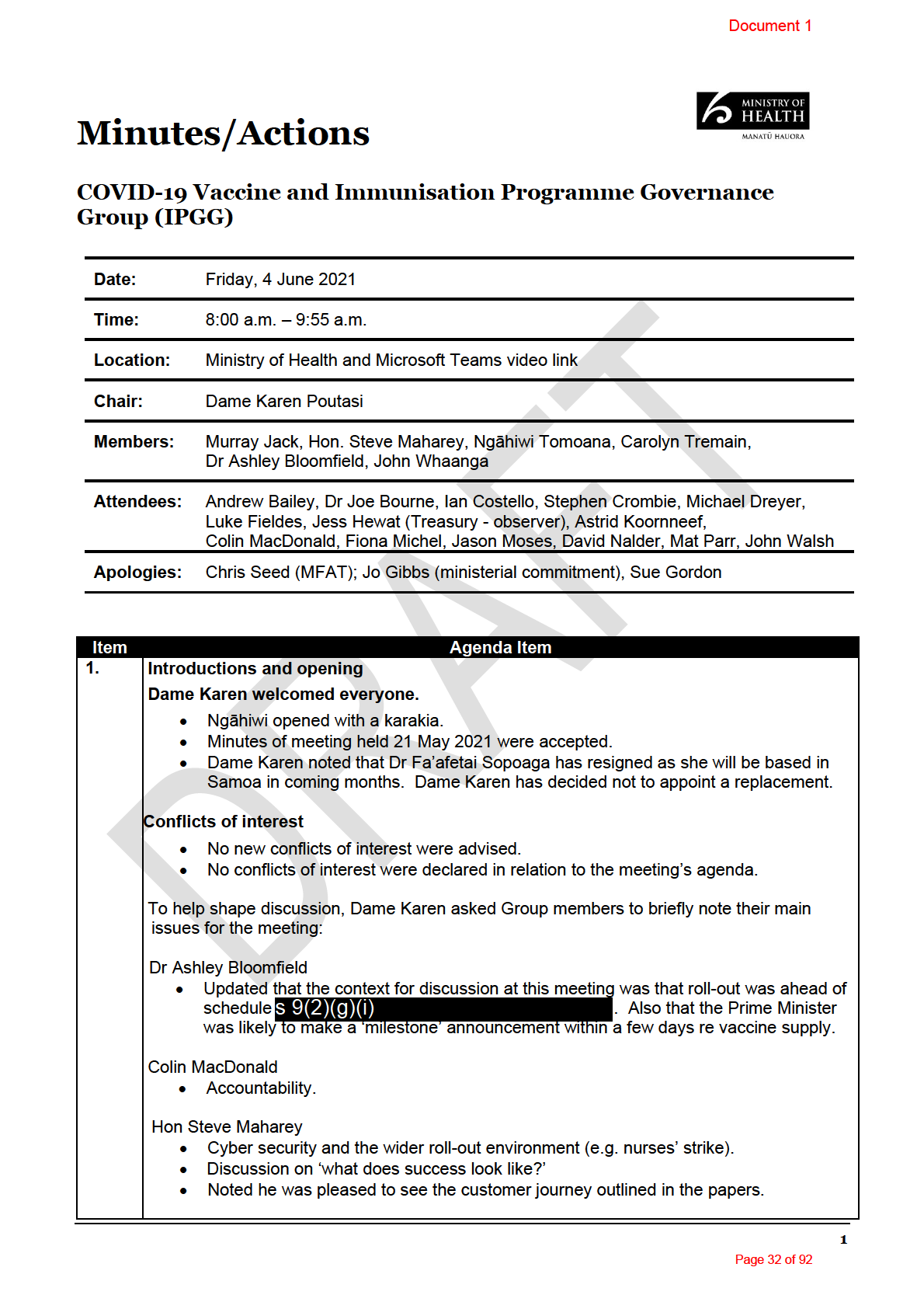
1982
ACT
INFORMATION
OFFICIAL
THE
UNDER
RELEASED
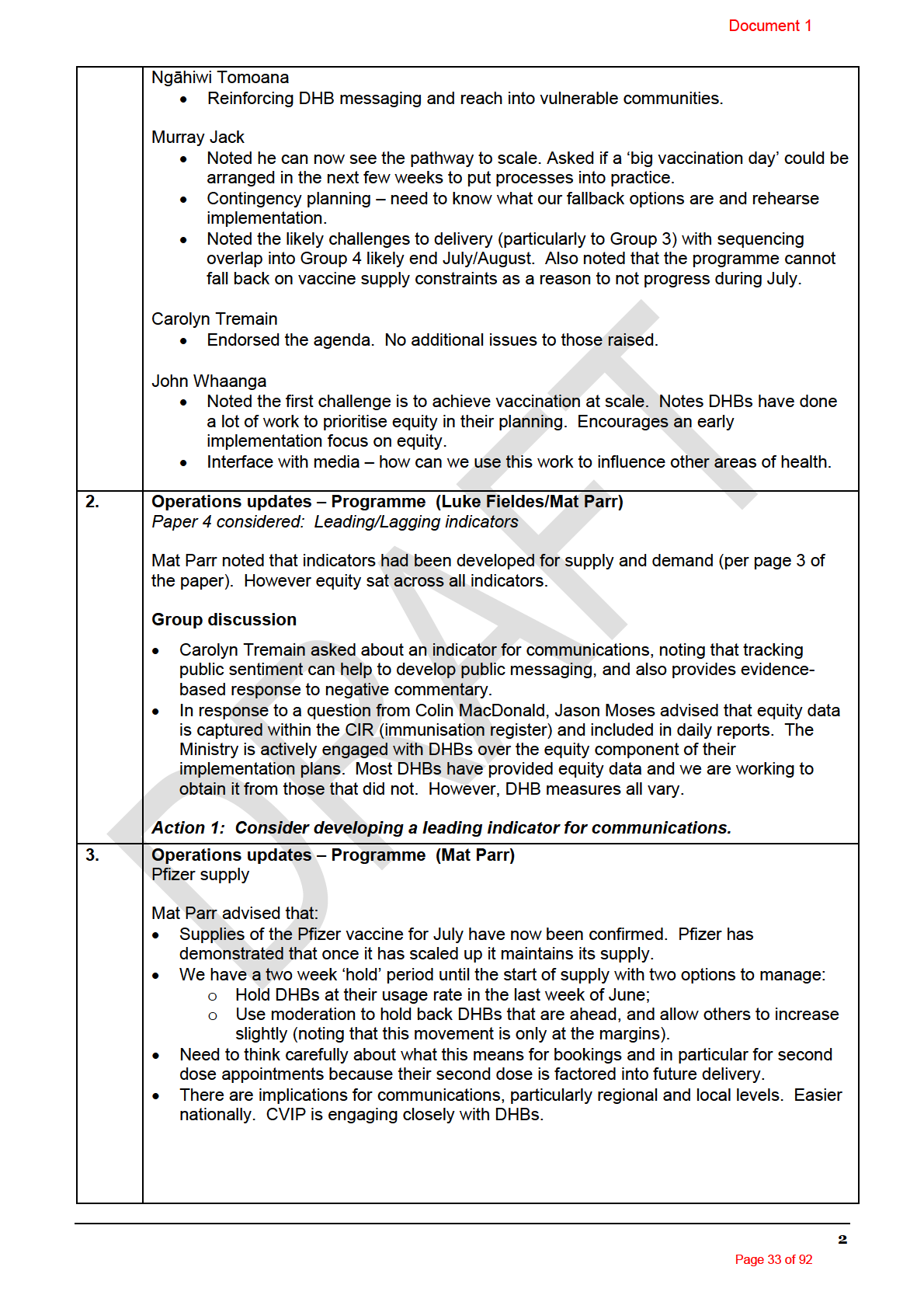
1982
ACT
INFORMATION
OFFICIAL
THE
UNDER
RELEASED
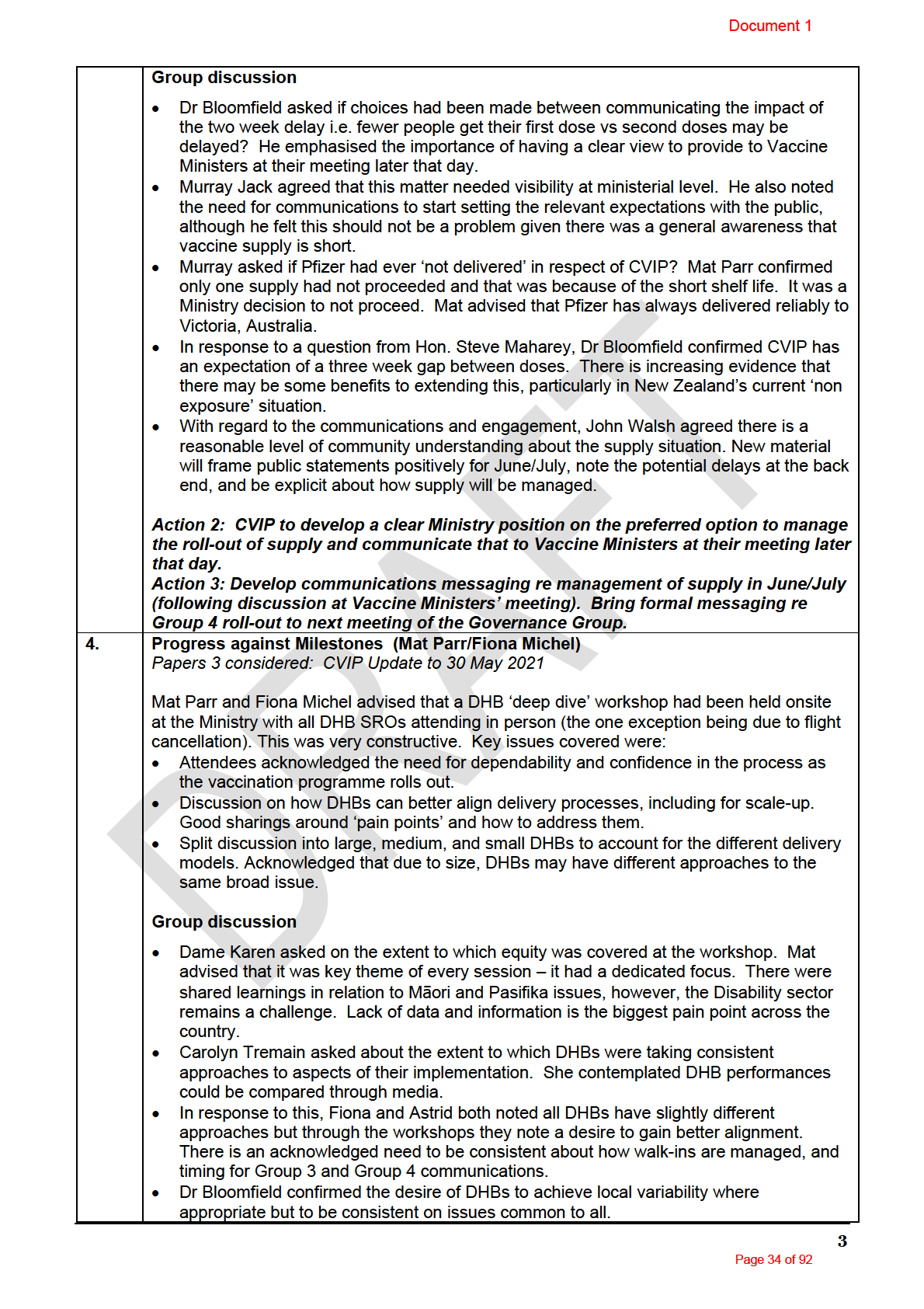
1982
ACT
INFORMATION
OFFICIAL
THE
UNDER
RELEASED
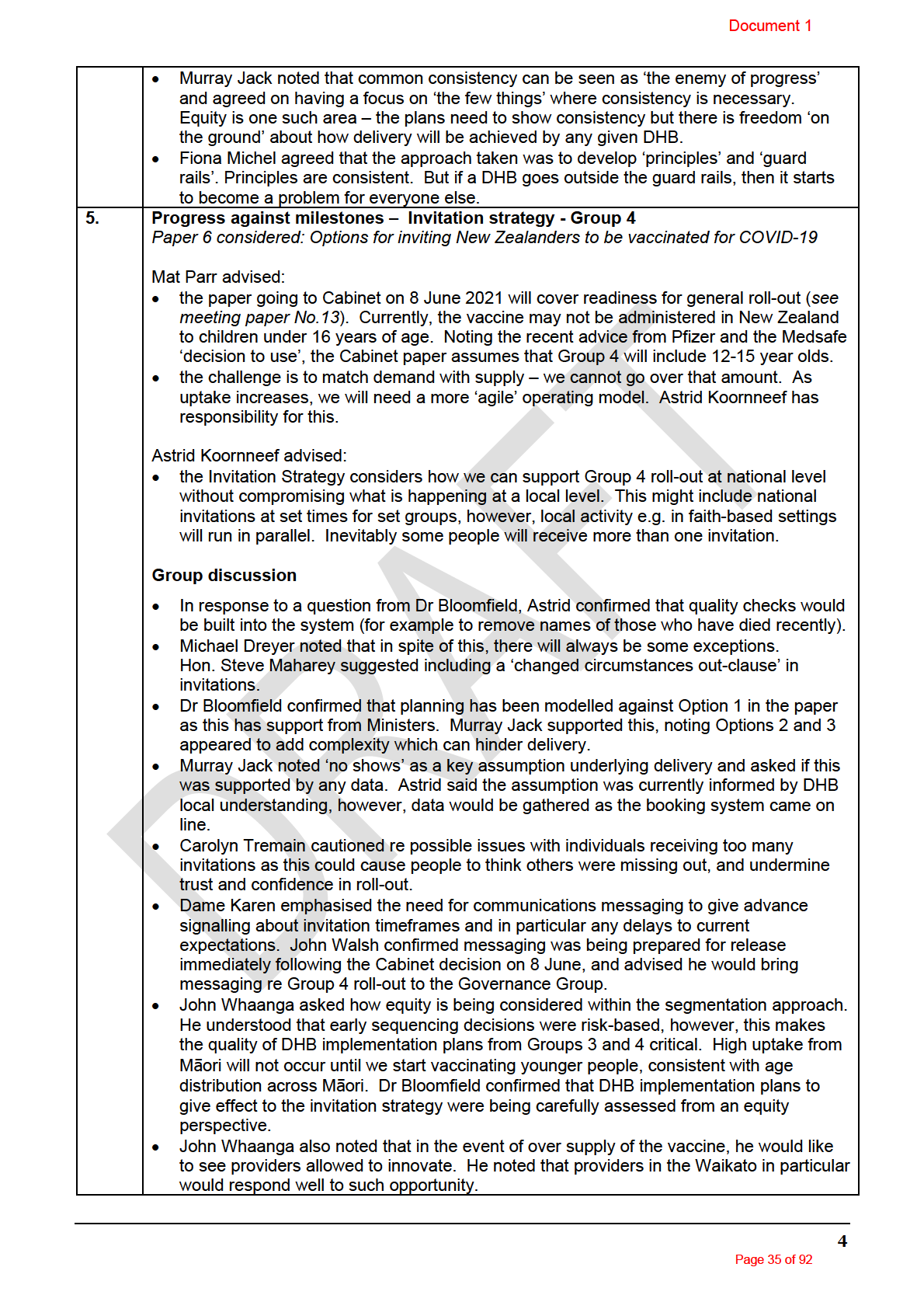
1982
ACT
INFORMATION
OFFICIAL
THE
UNDER
RELEASED
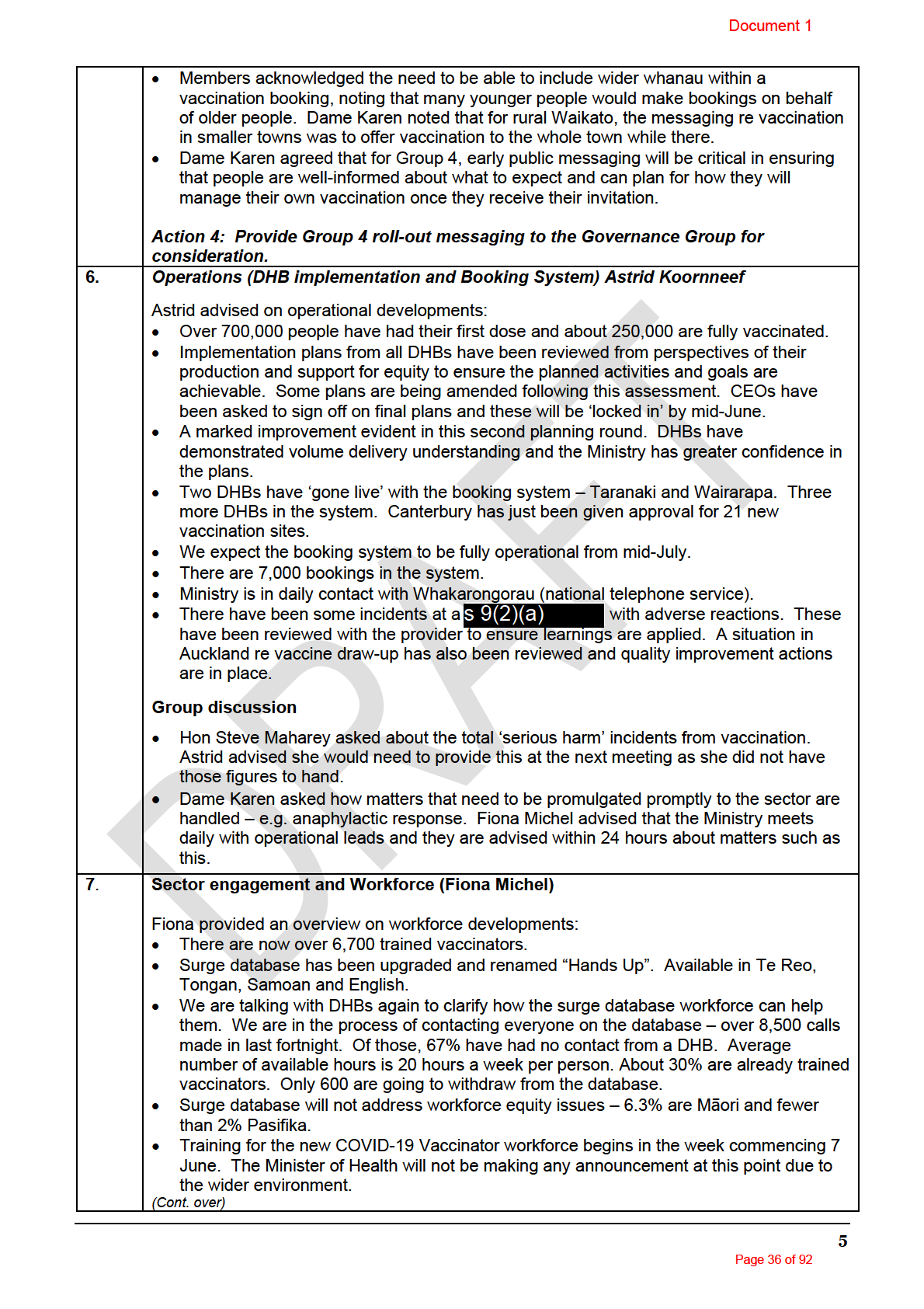
1982
ACT
INFORMATION
OFFICIAL
THE
UNDER
RELEASED
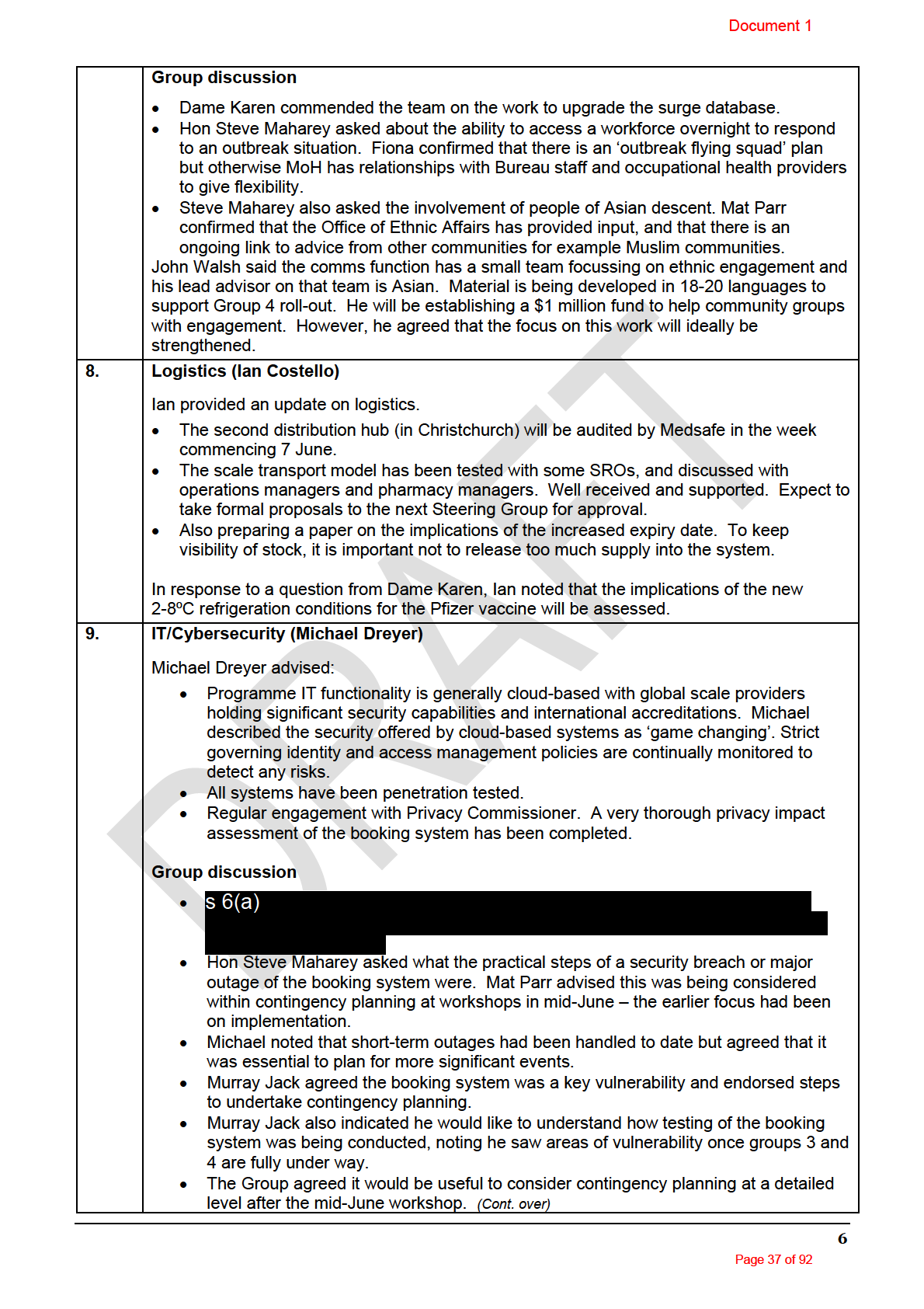
1982
ACT
INFORMATION
OFFICIAL
THE
UNDER
RELEASED
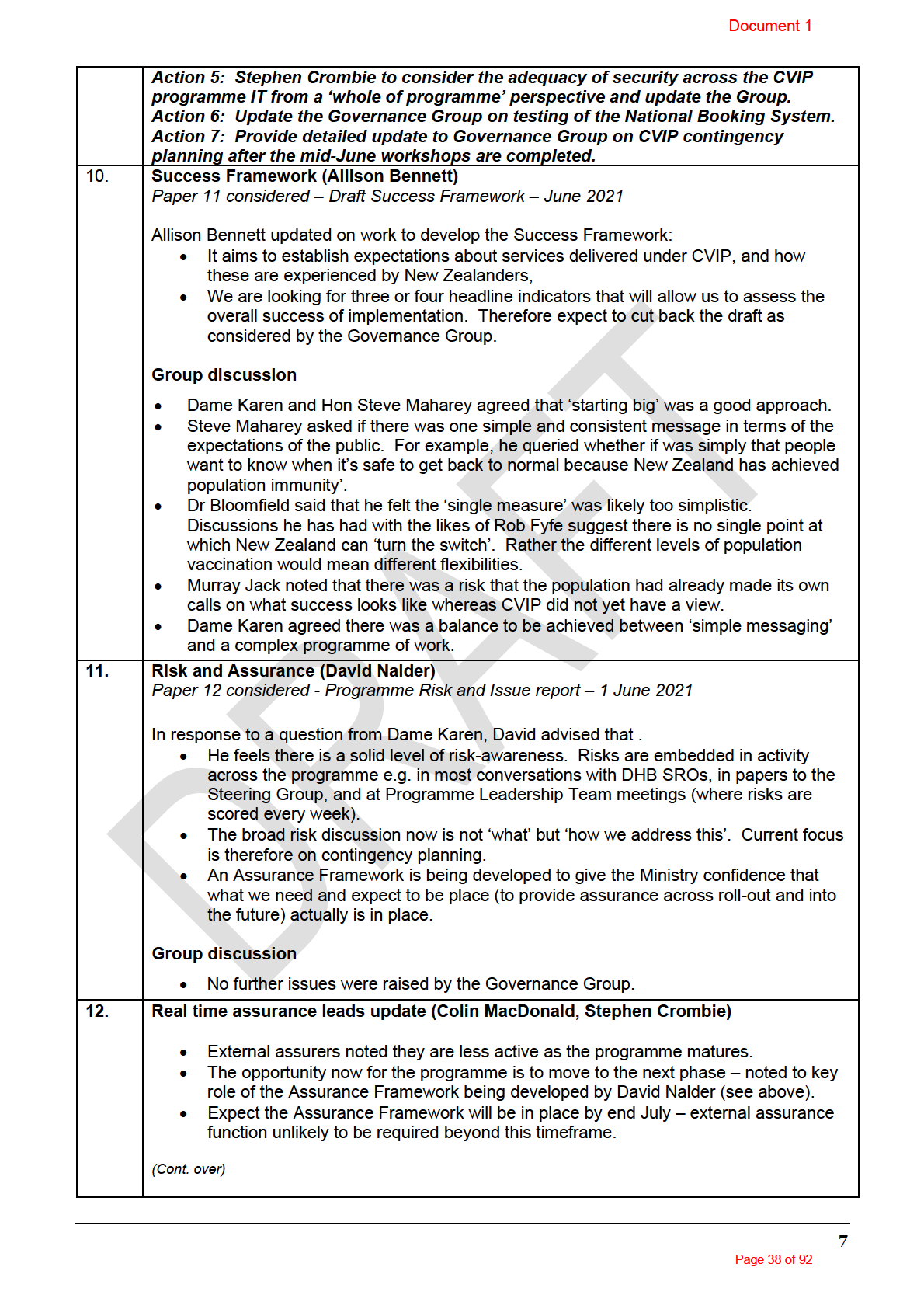
1982
ACT
INFORMATION
OFFICIAL
THE
UNDER
RELEASED

1982
ACT
INFORMATION
OFFICIAL
THE
UNDER
RELEASED
Document 1
Out of scope
1982
ACT
INFORMATION
OFFICIAL
THE
UNDER
RELEASED
Page 40 of 92
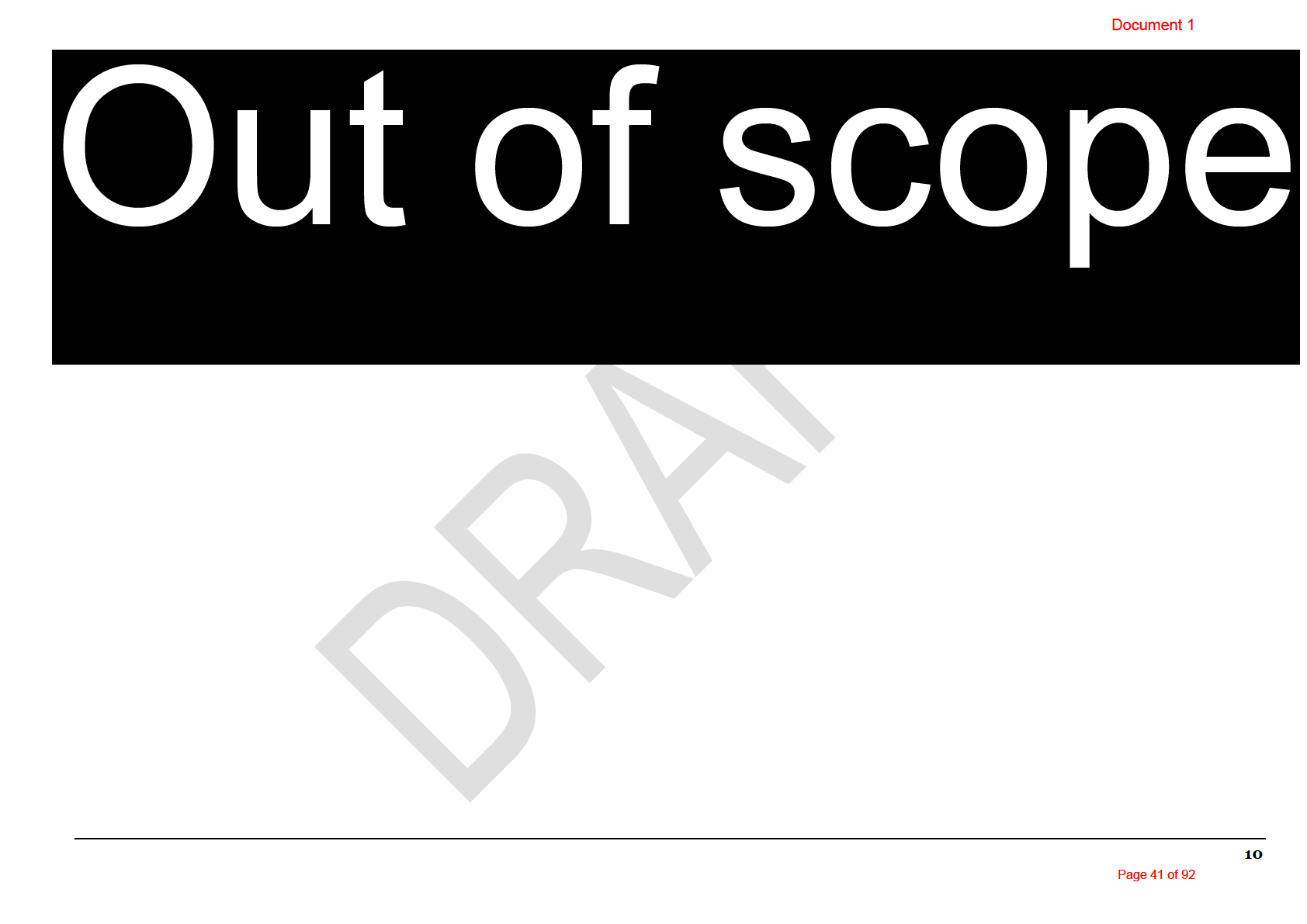
1982
ACT
INFORMATION
OFFICIAL
THE
UNDER
RELEASED
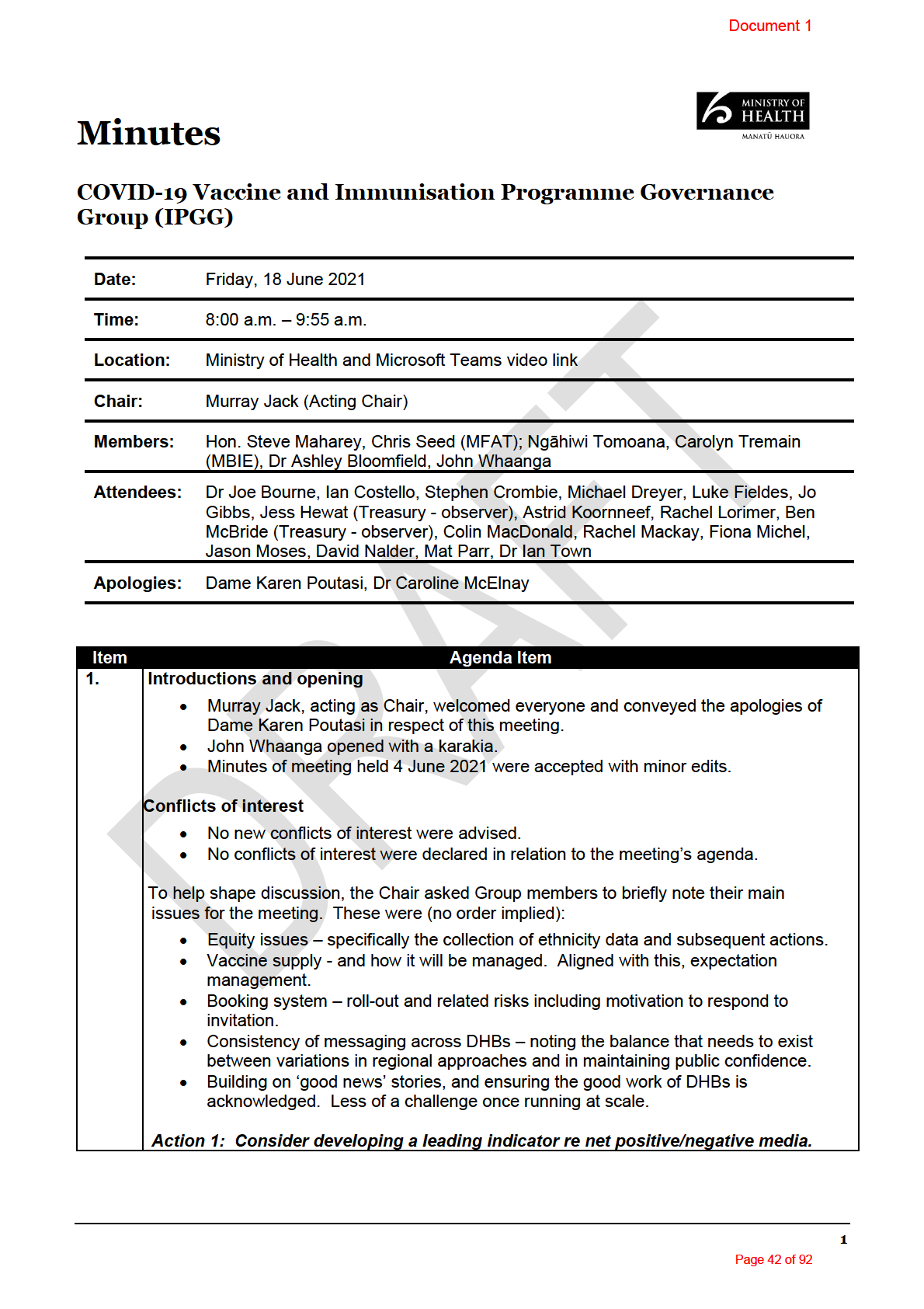
1982
ACT
INFORMATION
OFFICIAL
THE
UNDER
RELEASED

1982
ACT
INFORMATION
OFFICIAL
THE
UNDER
RELEASED
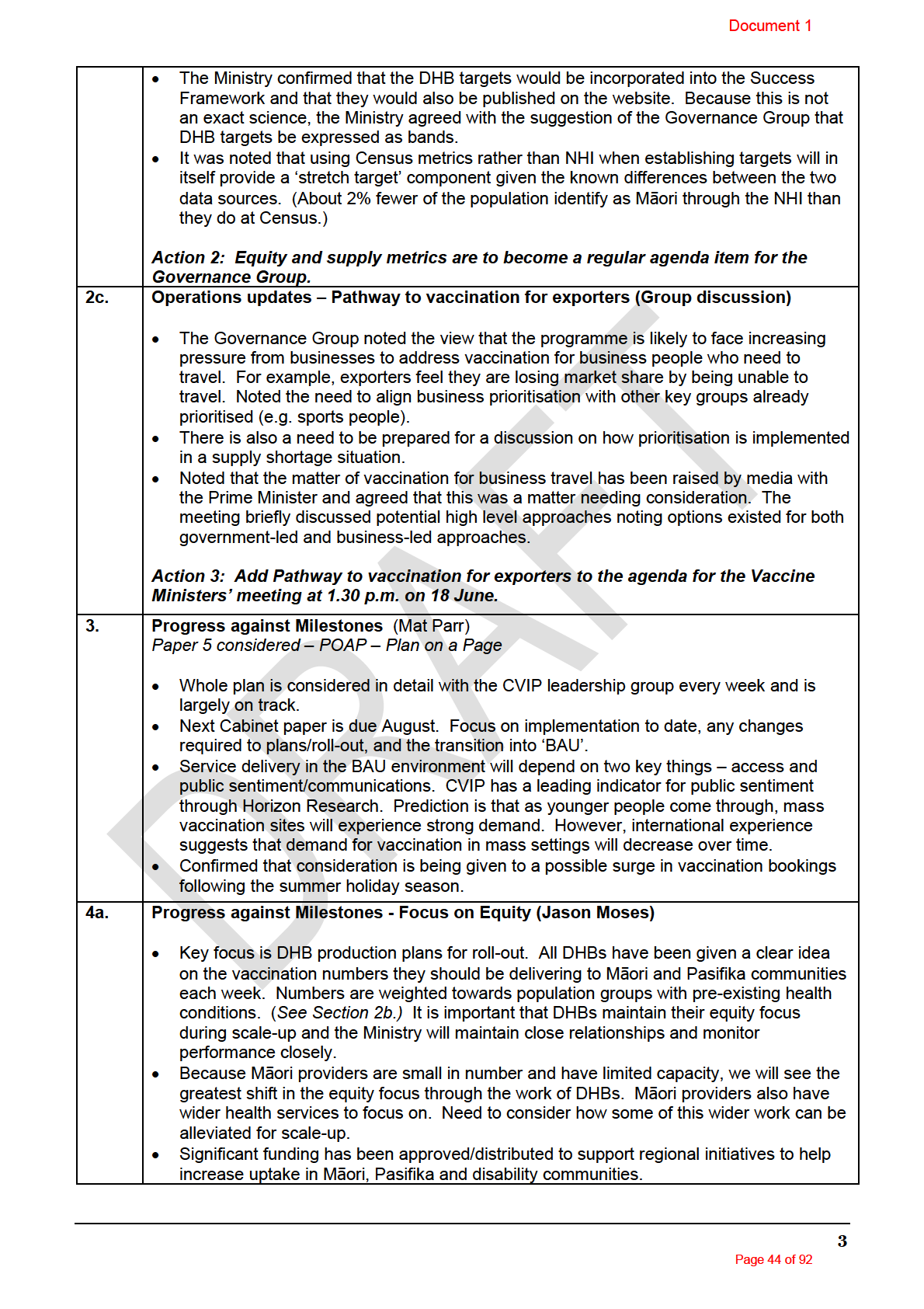
1982
ACT
INFORMATION
OFFICIAL
THE
UNDER
RELEASED

1982
ACT
INFORMATION
OFFICIAL
THE
UNDER
RELEASED
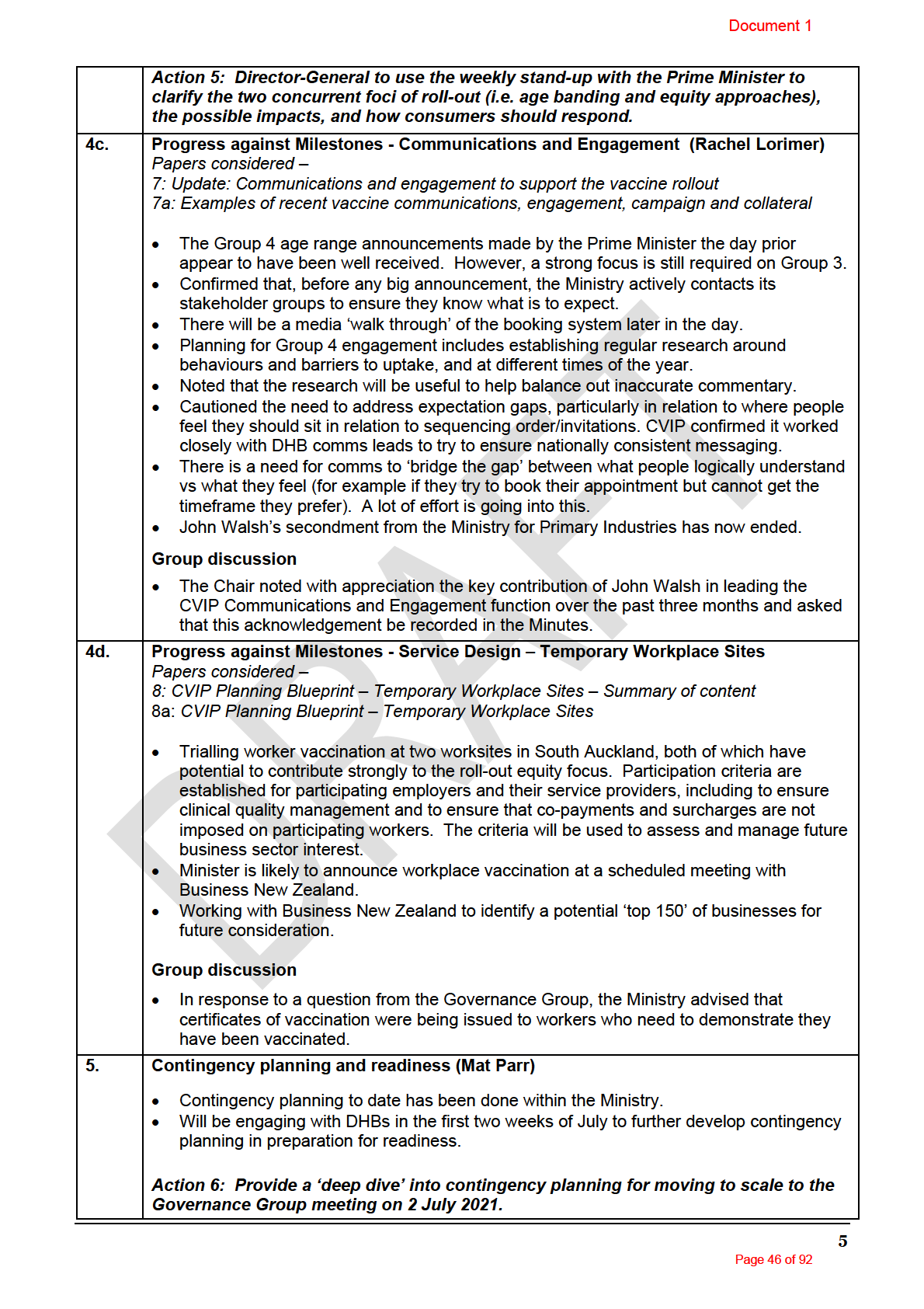
1982
ACT
INFORMATION
OFFICIAL
THE
UNDER
RELEASED

1982
ACT
INFORMATION
OFFICIAL
THE
UNDER
RELEASED

1982
ACT
INFORMATION
OFFICIAL
THE
UNDER
RELEASED
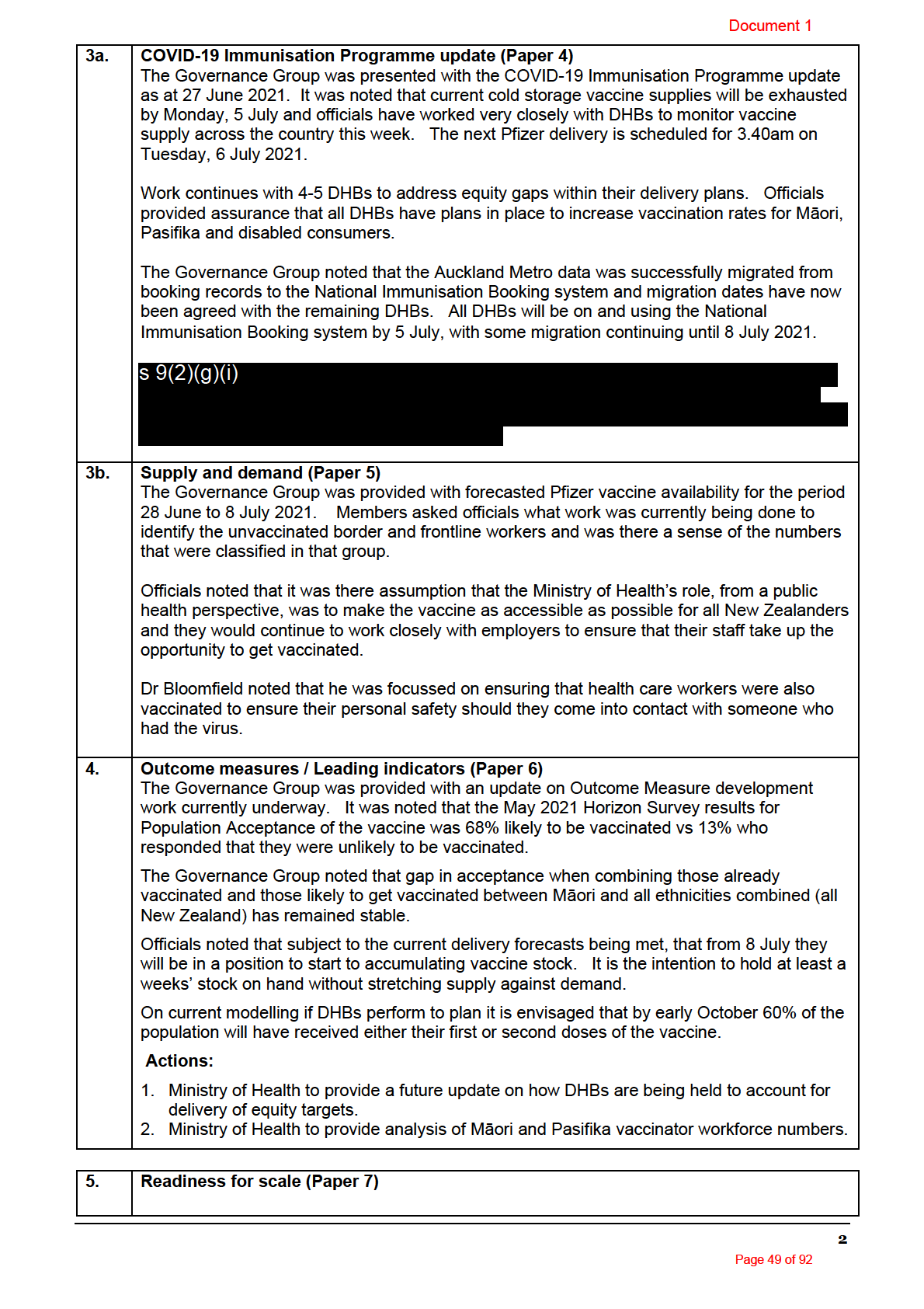
1982
ACT
INFORMATION
OFFICIAL
THE
UNDER
RELEASED
Document 1
The Governance Group was provided with an overview of the process for ensuring the rollout
of COVID-19 vaccinations across New Zealand is ready to scale for the scale and approach
needed for Group 4 (ie. open access to the general population). It was noted that the
Programme Leadership Team and the Steering Group had approved the readiness criteria
and that the Readiness to Operate at scale had been designed with equity, safety, experience
and efficiency success measures at the core.
Of icials noted that they were now in receipt of signed accountability documents from all
DHBs and National Providers and they were confident that there was good assurance with
clear accountability measures.
The Governance Group congratulated the team for the work completed with the assurance
framework, as it provided them with high confidence around the detailed assessment of
readiness.
1982
Dr Bloomfield acknowledged the considerable work that had been done to ensure a robust
and rigorous readiness assessment had been completed.
Actions:
ACT
1. Ministry of Health to provide at a future meeting any impacts the health reforms may have
on DHBs and how these can be mitigated to ensure that they do not impact on the
vaccination programme.
6.
Risk summary (Paper 8)
The Governance Group was provided with an update on the Covid Vaccine Immunisation
Programme risks and noted that the Programme Leadership Team were actively managing
any changes in risk ratings.
The Governance Group noted their confidence that management would continue
INFORMATION to manage
any risks identified in the programme.
7.
Contingency planning (Paper 9)
The Governance Group was provided with an update on contingency planning and noted the
recommendations of the Steering Group:
1.
Note that the PLG has identified six probable
OFFICIAL risk scenarios that would affect the
delivery of the expected national plan
2.
Note that the PLG has agreed to a phased development of contingency plans for the
identified scenarios THE
3.
Note that the CVIP Contingency Plans for the six scenarios have been completed
4.
Note that all DHBs have Business Continuity Plans in place as part of the readiness
criteria to go to scale.
5.
Note that a workshop wil be held on 1 July to further integrate the national (COVID-
19 Response Team
UNDER ), CVIP and DHB plans to the identified scenarios.
6.
Note that a contingency planning desktop exercise wil be conducted in mid July.
7.
Agree that the programme contingency plans be externally peer reviewed (e.g.
National Emergency Management Agency) as part of the overall Assurance Plan.
8.
Agree the Programme Director to engage with the Auditor General in relation to the
contingency planning recommendation contained in the “Preparations for the
nationwide roll-out of the COVID-19 vaccine”.
The Governanc
RELEASED e Group was briefed on the contingency workshop held on 1 July 2021 and
noted the scenarios, preventative and responsive measures that would be invoked. The
Governance Group noted their level of comfort with the work done to date on contingency
planning.
8.
Vaccine certification and consumer channel update (paper 10)
The Governance Group was provided with an update on the work being led by the Ministry of
Transport (MOT) and the Border Executive Board (BEB) to develop a digital COVID-19
3
Page 50 of 92
Document 1
Vaccination Certificate, which could be used as proof of vaccination for both workplace and
travel requirements.
Of icials led the discussion around the technology channels being explored and the intent to
ensure ease of use for consumers to access vaccination details, but also other health
records.
The Chair asked what steps were being taken to ensure equity of access for all New
Zealanders, and officials assured the Governance Group that due consideration would be
given to ensure equitable access to records.
9.
Realtime Assurance update
Stephen Crombie advised the Governance Group that this was his last meeting, as an
external auditor and it was his view that the Covid Vaccination Immunisation Programme was
1982
on the right path. The programme was delivering and the combination of having the strong
leadership, combined with the right people doing the rights things in a methodical manner had
the programme well positioned for success. Stephen Crombie acknowledged the Assurance
ACT
processes that had been put in place, as well as the great partnership between Operations
and Technology who have demonstrated a strong working relationship with a focus on
deliverables for the end user.
The Chair thanked Stephen Crombie for his contribution and the role that he had on the
Governance Group to provide real time assurance.
Dr Bloomfield echoed the sentiments of the Chair and noted that it would be beneficial to
capture and document the initiative to use a Governance Group as the benefits would be
measurable across many other government agencies.
INFORMATION
10.
Other business
Communications
The Governance Group was provided with an update from the Communications Group
Manager on current deliverables and resourcing. It
OFFICIAL was noted that the CVIP Communication
team worked closely with the DHB Communications teams to support them in delivering key
messaging locally in alignment with the national messaging. A Māori communications
strategy had just been signed off whi
THE ch would provide more guidance and confidence across
the programme. The strategy had been widely consulted with iwi and was currently with
Minister Henare’s office for his information. The Governance Group would be provided with
a copy in due course.
The Governance Group noted that there was stil some noise amongst media outlets with
UNDER
negative messaging and acknowledged the national and local efforts to mitigate negative
stories.
Actions:
1. Ministry of Health to provide a copy of the Māori communications strategy to Governance
Group in due course.
RELEASED
11.
Chair’s sum up of focus areas for the programme arising from meeting
The Governance Group members:
• Noted the programme was well positioned and looked forward to scale up and
readiness.
• The programme is well ahead of the game, congratulations to all on the work done to
date.
4
Page 51 of 92
Document 1
• Urged officials to seize the opportunity to capture the positivity around the programme
– things are being delivered.
• Confidence in management to identify and manage risks.
12.
Meeting close
The Chair closed the meeting at 9.25am, and asked Ngahiwi Tomoana to say a prayer.
The next meeting was scheduled for Friday, 16 July 2021 from 8.00am – 10.00am.
1982
ACT
INFORMATION
OFFICIAL
THE
UNDER
RELEASED
5
Page 52 of 92
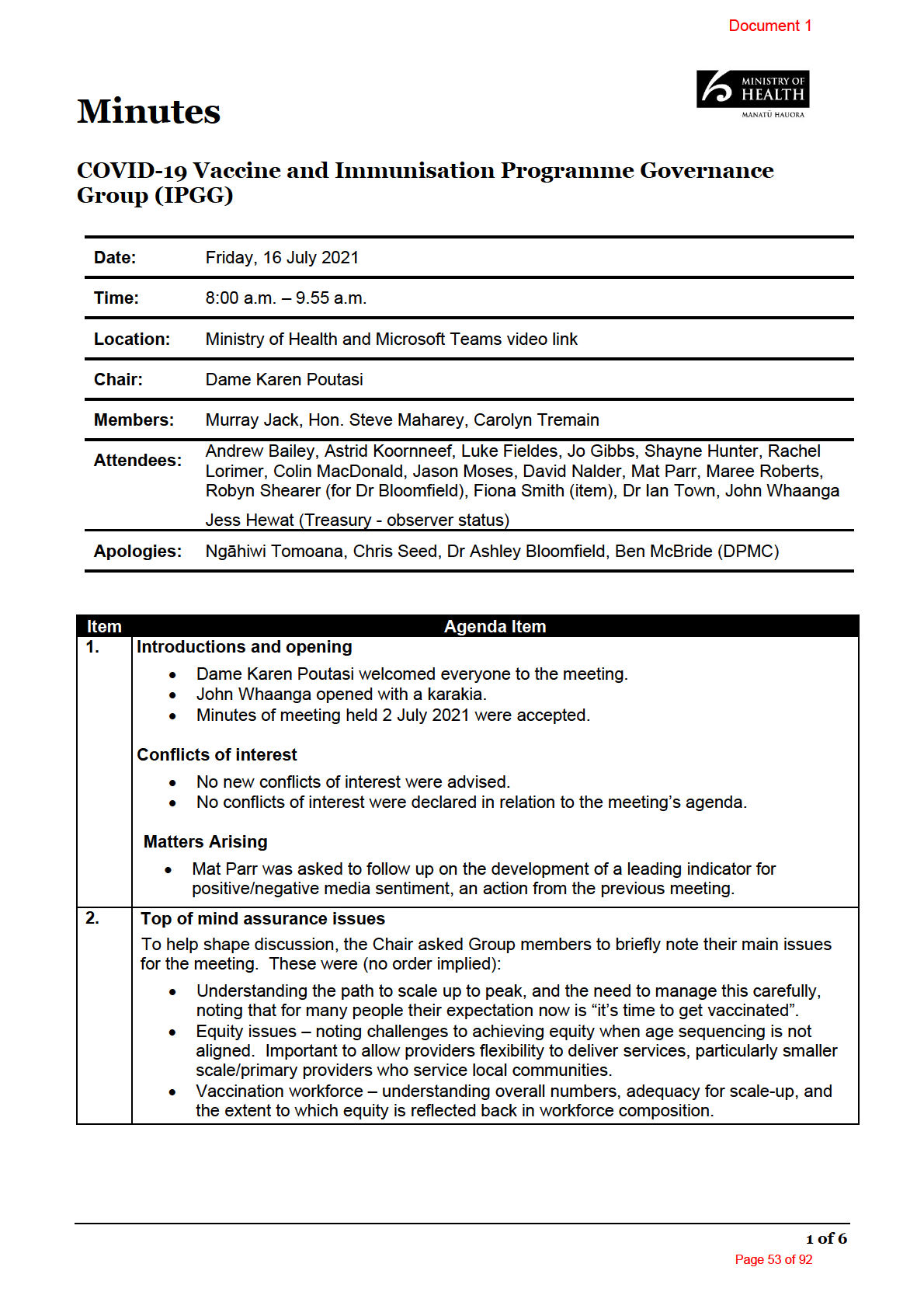
1982
ACT
INFORMATION
OFFICIAL
THE
UNDER
RELEASED
Document 1
3.
COVID-19 Immunisation Programme update (Jo Gibbs)
3a.
Paper 4 – COVID-19 Immunisation Programme Update – 11 July 2021
• The vaccine supply situation is stil tight. Two DHBs ran out of stock for a short period
whilst waiting for new supply to arrive from the hub.
• Situation is closely monitored. The quality and completeness of information held on the
Ministry’s portal about each DHB’s stock in hand is improving.
• Further vaccine supply due Tuesday 20 July. This will be distributed to service providers.
It will take some time to build up contingency stock. Situation should ease a bit towards
early August as larger shipments arrive.
• The national booking system is now live across all DHBs. Available vaccination slots are
viewable and bookable. Only some older bookings made by DHBs remain outside the
system and will be transferred manually.
Group discussion
1982
• The Governance Group noted that the ‘live’ status of the national booking system is likely
to remove a deterrent for many who prefer to make their own arrangements.
ACT
• The Ministry noted that the new challenge is to ensure that the forward capacity is loaded
(by the DHBs) into the booking system.
3b.
Communications and engagement –
general approach (Jo Gibbs/Rachel Lorimer)
• Al DHBs have commit ed to getting their Group 3 invitations out by 23 July. The Ministry
is monitoring this on a daily basis. The original commitment – Group 3 notifications out by
end June – happened substantially, but not entirely.
• Media messaging wil advise people aged over 65 years who haven’t received an
invitation of the number they can phone to book an appointment.
• The week of 23-28 July wil be a ‘hiatus’ to allow for reservations to take pl
INFORMATION ace. The
national call centre wil be open for five days from 17 July, but this wil only be announced
through local level communications to make sure that early call load is manageable.
• Whakarongorau has staffed up significantly and the Ministry is monitoring this to ensure
capacity meets demand.
• The Minister is likely to make the announcement to open to the first people in Group 4 on
28 July.
OFFICIAL
Group discussion
• The Governance Group noted a
THE change in the focus of comms from “we will contact you
about your vaccination” to “please contact us if you don’t have a booking”.
• The Governance Group also noted the need to manage expectations (consumer and
provider). Ideally all those in Groups 1, 2, and 3 wil be booked by end July.
• The Ministry agreed, advising:
• For consumers, the
UNDER ability to book online was unlikely to translate into an immediately
available vaccination slot, with waits of up to six weeks in some cases;
• For providers, there was a need for ‘tighter’ comms, depending on the provider’s
delivery model e.g. age band approach, whānau vaccination.
• Therefore the Comms campaign had two sets of messaging so that those identifying in
the system as Māori or Pasifika would receive a whānau invitation.
• Consumers were encouraged to book online, however, were also advised to phone in if
they prefer
RELEASED red to have their booking managed for them.
3c.
Invitation strategy – the sequencing/age banding approach
• Members of the Governance Group raised a number of issues about the sequencing
approach.
• Members noted the overlay of much of Group 3 with Group 4 and the comms and other
implications of this. They asked what criteria Ministers were working to when making
decisions re extension of the vaccination age bands. Criteria would better clarify the likely
2 of 6
Page 54 of 92
Document 1
implications of decisions, and support robust decision-making when deciding to launch a
new age band.
• The Ministry advised that the decision was made in June that Group 3 would be invited
across June to September 2021. This has not changed, however, with Group 4 roll-out
beginning, booking slot availability may come under pressure. Ministers are aware that
booking windows are 6-8 weeks out.
• This situation also has implications for comms and messaging (see section 3b).
Group discussion
• Members noted the differing approaches of some DHBs to approaching their Group 4
consumers. Where DHBs who do not extend invitations promptly after ministerial
announcement, this skews demand, and therefore also response. Lower response
volumes do not necessarily mean low interest. Members also noted consumer
perceptions risks from delay.
• Members were strongly of the view that criteria should be developed to inform sequencing
1982
decisions.
• Members suggested that sequencing and cohorts were really theoretical constructs and
potentially almost impossible to deliver on the ground. Addressing overlaps between
ACT
Groups 3 and 4 wil be problematic, particularly as service delivery moves out more widely
and into primary care. This diversity of delivery is good – but it provides challenges in
terms of expectations management.
Action 1: Ministry to consider developing decision criteria for sequencing. (Mat Parr)
4.
Outcome Measures/Leading Indicators (Luke Fieldes/Astrid Koornneef)
Paper screen shared – Operational Capacity for Tier 4 subgroups
• To help give us confidence in delivery, we need to understand how capaci
INFORMATION ty within the
booking system interfaces with DHB production plans.
• The chart shows how far through its delivery to a particular cohort any given DHB is when
Ministers make their next announcement. Currently quite significant overlaps can be seen
in many cases.
• DHBs can now see this data and are starting to gain an understanding of how they can
best use it.
OFFICIAL
• Having a better understanding of booking availability in relation to demand also:
o helps us to manage expectations, i.e. to frame up comms with those making
bookings;
THE
o can help Ministers to understand the system’s ability to support new age band
announcements at any given point.
• It can delineate by both first and second doses.
• Noted that the booking system does not currently include primary care. Projections
therefore include the primary care element stated within each DHB’s production plan.
UNDER
Projected bookings for primary care wil be refined as we gain more information into the
future.)
Group discussion
• The information provided is quite revealing in terms of the capacity in the system. The
issue is how this can be used to inform decision-making re opening up new cohorts.
• What level of flexibility does this approach have e.g. to report on activity within age groups
RELEASED
by particular DHBs?
5.
Programme Status (Andrew Bailey)
Paper 6 – COVID-19 Vaccination and Immunisation Programme Schedule Summary Update
12 July 2021
• This is a new report which aims to highlight the current status of each workstream,
providing a two-week view.
6.
DHB Accountability of equity targets (Jason Moses)
3 of 6
Page 55 of 92
Document 1
Paper 7 – Monitoring and Accountability Measures to support District Health Boards in
meeting Equity Targets
• A number of measures support DHB accountability for their equity targets.
• The equity data table (paper 7a) shows DHB actual and planned performance (for Māori
and Pacific peoples). There are some high performers, such as Capital & Coast and Hutt
Valley, where a recent vaccination event for Pacific people had been very successful
across both Māori and Pacific.
• However, the data table shows that whilst DHBs are able to achieve broad production
volumes, many are struggling with equity targets.
• The Ministry meets DHB SROs on a weekly basis to review performance.
General discussion
• The Governance Group noted that under an age-banded sequencing approach, Māori and
1982
Pacific populations will disproportionally come in the younger age bands.
• The suggestion was made that the programme think about ‘what attracts younger people
to get vaccinated?’ This is a wider question than just for Māori and Pacific
people.
ACT
o The Ministry noted that its research plan provides focus group information about
vaccination behaviour which informs messaging.
• Encourage flexibility in vaccination service provision by freeing up provider capacity from
other contractual obligations where possible. Ef ective vaccination is bigger than
administering the vaccine. Local providers are key connectors and have a comms role to
play. Al ow providers to create the right environment for their communities.
7.
Choices to support uptake and scale Q3 and Q4 (Mat Parr, Joe Bourne, Vince Barry)
Papers 8 and 8a – Q4 Strategy discussion – 12 July 2021
INFORMATION
• Previous modelling to reach ‘scale’ has been based on 70 per cent uptake.
• Research in New Zealand by Horizon shows that 80 per cent of people are now wil ing to
be vaccinated.
• A stretch ambition of 85% is therefore proposed for planning purposes.
• International experience shows there is an eight-week window of working at peak before
delivery starts to reduce. September and Octobe
OFFICIAL r are identified for focus in New Zealand.
• There are three settings possibilities to ‘push’ uptake:
o Through primary care settings;
o Through mass events;
THE
o Through schools (i.e. delivery to students, noting that school settings are already
being used by some DHBs as these provide a trusted site for e.g. whānau
vaccination).
• DHB production plans are signed off to end of September and will an increase for the
period post-August to del
UNDER iver the 85% ambition.
• Current planning was for around 800 vaccination sites. Significant effort is required to
onboard the necessary number of new sites to push fully into primary care (expected
requirement 2,000 sites).
Group discussion
• Messaging about supply needs careful consideration to reflect reality but retain
RELEASED
confidence. New supply has arrived but must stil be managed as the supply is not infinite
for some time yet.
• Messaging – including to Ministers – must be disciplined. Basically, wider roll-out has
started but we continue to need to manage supply so that we can meet demand.
Planning might include some mass vaccination events so that those eager to be
vaccinated have an earlier opportunity.
8.
Funding and Finance Update (Fiona Smith)
4 of 6
Page 56 of 92
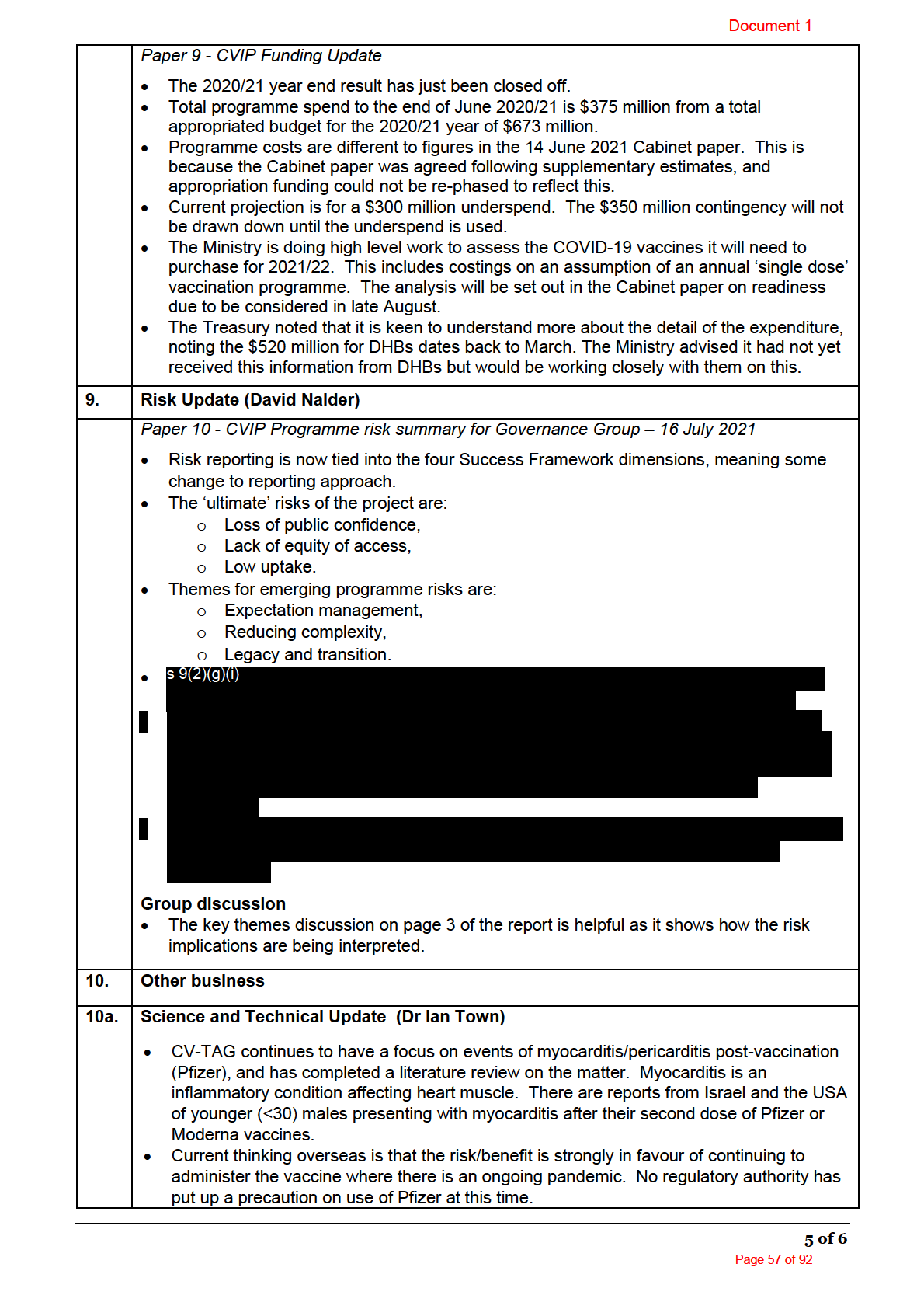
1982
ACT
INFORMATION
OFFICIAL
THE
UNDER
RELEASED
Document 1
• Questions to be addressed for the use of the Pfizer vaccine in New Zealand are:
o how this might impact on the use of the vaccine to 12-15 year olds and
o how Pfizer should be administered to ‘younger males’, e.g. those aged under 30
years.
• Advice is being prepared for the Director-General on these mat ers and wil be considered
at a future Steering Group meeting.
Group discussion
• In response to a question about Australia’s position on this matter, the Governance Group
was advised that the context in Australia is dif erent, however officials here would be
making contact with Australian officials to compare notes.
• In response to a further question regarding the use of other vaccines in New Zealand,
including Janssen, the Group was advised that a Cabinet paper was being prepared on
the future vaccine portfolio for New Zealand, for likely consideration mid-August. 1982
• Having more than one vaccine in the portfolio protects against the risk of supply chain
issues.
• As a single dose vaccine, Janssen may be a good alternative for those who cannot
ACT have
Pfizer due to side effects.
10b. Realtime assurance update
• Noted that this function had now ceased, with the programme assurance plan picking up
this activity. Colin MacDonald was now focusing on supporting the programme with
thinking around transition to the future state, and on CVIP legacy activity.
• The letter of thanks to Stephen Crombie was noted.
11.
Sum-up of Governance Group’s focus areas for the programme arising from meeting
INFORMATION
• Ensuring public communisations manage expectations around progress through Group 3
and the opening of Group 4.
• Invitation sequencing – consider developing criteria to help inform decision-making.
12.
Meeting close
The meeting ended at 9.55 a.m.
John Whaanga closed the meeting with a prayer.
OFFICIAL
13.
Next Meeting
Friday 30 July 2021, 8.00 a.m. – 10 a.m.
THE
UNDER
RELEASED
6 of 6
Page 58 of 92
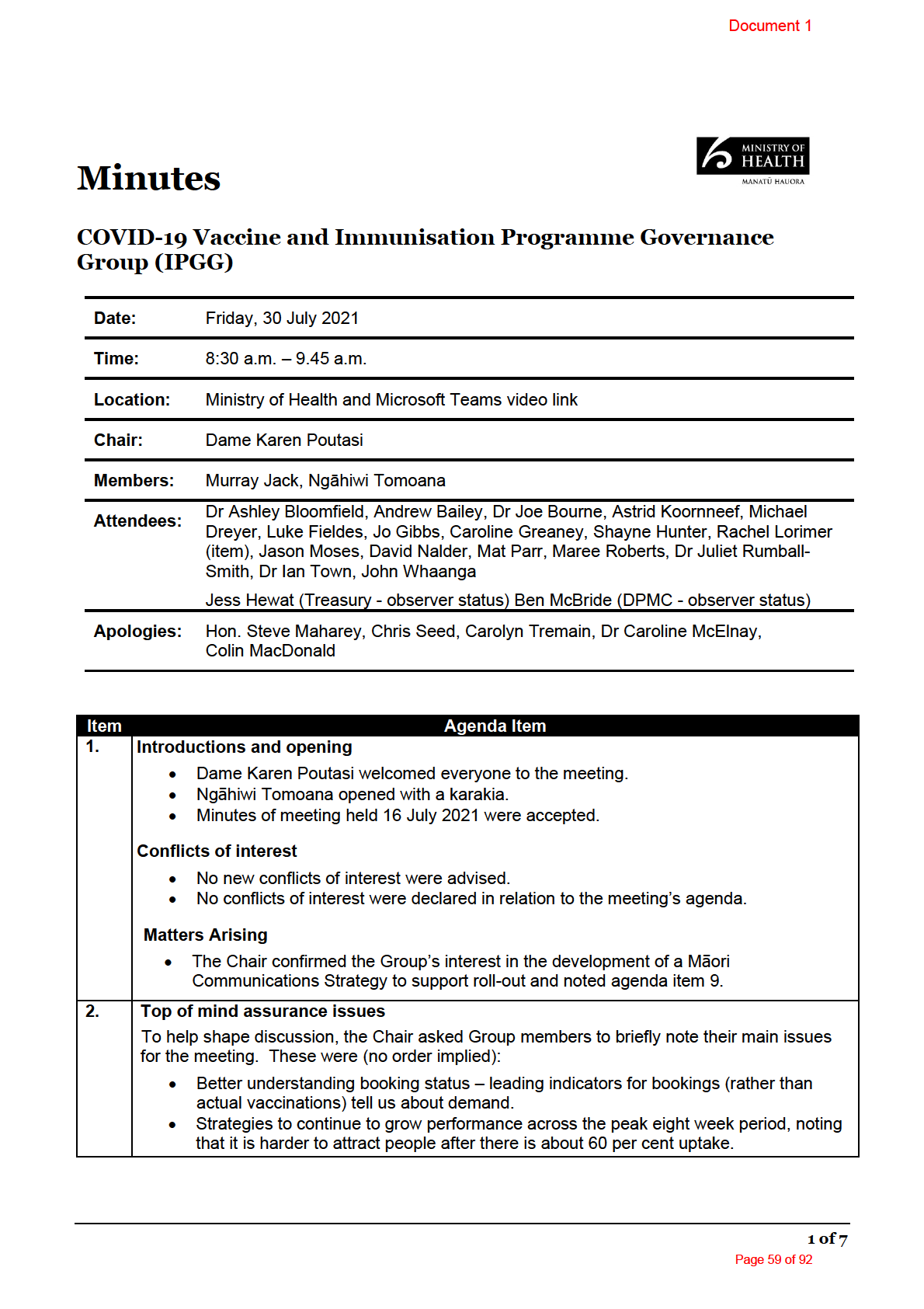
1982
ACT
INFORMATION
OFFICIAL
THE
UNDER
RELEASED
Document 1
• Confidence in delivery – Current delivery about 50,000 doses per day, however, if we
had pressure to go over this and ample supply, how would we deal with this?
Consider resource adequacy, points of delivery etc.
• Equity –
o there is a national push but it is not always translating into results for Māori and
Pacific people. Different DHBs face different issues. We need to understand
what is happening at a regional/local level.
o We need more nuance in how we communicate what the data is showing. The
actual story (Māori and Pacific people in older age groups are being
vaccinated at similar or higher rates to non-Māori, non-Pacific) is better than
the story reflected in public commentary and through production planning.
• Need to balance ‘understanding who the cohort is’ with ensuring the right opportunities
to be vaccinated at provided to these groups. The latest Horizon research shows that
the age group with the lowest intent is 20-40 years. Mass vaccination events may be
an effective way to reach this group.
1982
3.
COVID-19 Immunisation Programme update (Jo Gibbs)
Paper 4: COVID-19 Immunisation Programme Update – 25 July 2021
ACT
• Significant milestones – opening of “Book my Vaccine”, launch of the bookings phone
number, media advertisements targeting the over 60s.
• Another big week for vaccinations, with a seven-day rolling total of 220,000 vaccinations.
• Good data is coming through the “Book my Vaccine” system:
o 62,000 bookings on 29 July 2021.
o 920,000 forward bookings in the system.
• There are 261 primary care service providers (bookings not in the booking system.)
• Now have over 10,000 trained vaccinators. Have taken on additional resource and expect
to have cleared the backlog caused by the process change by 8 August.
INFORMATION
• Solid progress in workplace-based vaccination:
o Mainfreight wil hold a ‘wet run’ on 3 August and Fonterra on 10 August.
o 257 Expressions of Interest received for workplace-based vaccination from a
range of private and public organisations.
• Biggest risk remains achieving equity.
Group discussion
OFFICIAL
• Question were raised about progressing vaccinations for the balance of Groups 1 & 2 and
about the estimated workforce numbers requirements. These were addressed:
THE
o Groups 1 & 2 have ongoing turnover. DHBs have a system to prioritise these
bookings so there is no wait.
o Group 2 reach is good, with first round Aged Residential Care vaccination
completed.
o Most outstanding vaccinations are in Group 3 with some in Group 2.
UNDER
o DHBs with significant maritime ports are working with these ports to ensure access
for workers, noting the aligned mandatory testing regime.
o The Ministry expects to put advice to Ministers in about a week with plans to
encourage and place expectations on the health workforce to be vaccinated, and
to provide options for extending mandated vaccination to this group.
4.
Outcome Measures/Leading Indicators (Luke Fieldes/Astrid Koornneef/Michael Dreyer)
Paper 5: CVIP
RELEASED
Outcome Measures – Status update – data as at 26 July 2021
• This approach to better understanding capacity within the booking system, and interfaces
with DHB production plans, was signalled at the last meeting. We wil report using this
approach from now on.
• Now using HSU (health service utilisation) data produced by the Ministry as the
denominator for uptake measures. This means that, unlike the census data, we have a
known group as the denominator. We can use their gender, age, ethnicity attached to
their NHI and thus build up an accurate view of uptake. This can be analysed by age
band, territorial authority etc. Can help identify where future effort needs to be focussed.
2 of 7
Page 60 of 92
Document 1
• Careful watch on success factor ethnicity. While the current data is showing fairly good
results for those aged over 65 years, it is less positive for younger age groups. However,
this reflects the way the sequencing tool works.
• We aim to have all bookings included in this form of reporting (noting that primary care is
not currently included). Working on an IT solution to this.
• Expected benefits are that DHBs will have better oversight of their regional situation
(bookings, stock in hand, volumes) as smaller sites are brought into production.
Group discussion
• Endorsed the use of tools such as this to give good insights into performance.
5.
Risk Update (David Nalder)
5a.
Paper 6: CVIP Programme risk summary for Governance Group – 27 July 2021
• Reporting is tied to the four Success Framework dimensions.
1982
• Three key risks have been fairly consistent. These are embedding equity, legislative
compliance, and complexity and change. There is now more confidence on certainty of
vaccine supply, which had also been in the ‘key risks’ group.
ACT
• Consideration currently being given to Good Operating Practice performance and
mapping indicators through to risks to allow us to see emerging risks and trends.
• The paper describes all risks and provides a narrative of the programme’s response.
5b.
Paper 7: CVIP Update on recommendations from OAG performance audit report – July 2021
• In May 2017, the Office of the Auditor-General released its report on
Preparations for the
nationwide roll-out of the Covid-19 vaccine.
• The report noted the chal enges of planning for a large-scale immunisation programme,
and made six key recommendations. These covered transparency of communications
across a range of audiences, contingency planning and procuring vaccine s
INFORMATION upply.
• The Health Select Committee has asked the Ministry of Health for an update on its
progress in implementing the OAG recommendations.
General discussion
• Suggested that positioning the response within a wider picture of overall progress with
vaccination roll-out would provide useful context to the Select Committee.
OFFICIAL
5c.
Paper 8: CVIP Proposed Internal Audit Assessments – July 2021
• Seven internal audits are propos
THE ed in coming months to give assurance in the processes
supporting CVIP roll-out.
• Audits in three areas have been prioritised and wil take place August – October 2021.
These are:
o Service Standards assessment
o Technology Gene
UNDER ral Controls assessment
o Logistics assessment.
• Noted that the Service Standards assessment comprises a programme of reviews
touching on DHBs and vaccination sites.
• Both the Steering Group and Governance Group wil receive regular updates on progress
with this work.
General discussion
RELEASED
• Proposed approaches seem sound. However, some questions were asked about timing,
noting the October 2021 completion date signalled for two of the reviews and the fact that
the expected peak vaccination period (i.e. the roll-out programme in which people are
currently involved) wil be completed by this point.
o Unless there is regular interim reporting, there is a risk that the outputs of the
audits may not be able to benefit the programme directly. It was likely to take
about a month to do the work and then a similar timeframe to translate this into
activity.
3 of 7
Page 61 of 92
Document 1
o It is important to differentiate the changes/improvements that wil benefit the
programme implementation going forwards vs those that wil benefit the future
programme. Identified a lot of value going forwards from this work.
• It was suggested that if there was flexibility, consideration could be given to moving some
of this work forward.
• In response to a question, the Programme Director noted that the timing of this assurance
activity had to be considered carefully. Some systems have only just been set up (e.g.
the booking system) and there was a desire to not set too much assurance in place before
these systems were known.’
6.
Strategy for uptake for peak vaccination period (Mat Parr)
Paper 9: CVIP – Maximising Uptake Approach
• While the strong early focus of the programme was on confidence of vaccine supply, this
is now moving to the demand side.
1982
• This paper builds on the research information we have about vaccination wil ingness and
identifies how the programme wil work to achieve 85% vaccination uptake in Aotearoa
New Zealand. It also draws on recommendations from planning workshops held with
ACT
DHB SROs.
o Peak vaccination period wil be September to October 2021. In September there
will be a ‘pivot’ from a servicing a model where most appointments are pre-booked
to a model that services volume walk-ins. We have expanded our geographic
coverage of vaccination site locations. Decisions have included consideration of
travel times etc.
o Equity is a significant consideration. Dif erent groups wil need different service
models. People wil receive invitations through multiple methods.
o Need to avoid complacency due to New Zealand’s unique COVID-free status.
o We are considering the learnings from international experience.
INFORMATION
• Cabinet paper wil be developed for consideration in late August.
General discussion
• Currently we have the planning and the words – the communications and engagement
programme is critical to translate vaccination wil ingness into action/uptake.
OFFICIAL
• In response to a question, the Ministry confirmed that the modelling was mindful of the
quantum of confirmed supply. It has been carefully planned to avoid stock depletion and
the subsequent delivery and confidence impacts this would have. However, the point was
THE
then made that managing the supply curve and pushing appointments out also had risks
(disengagement).
• The Ministry noted the current wider demands on the health workforce – including winter
il nesses, and the fact that many nursing staff have been moved to work in managed
isolation or quarantine facilities. CVIP roll-out must achieve a balance without
UNDER
compromising the rest of the system.
• The suggestion was made simply inviting all Māori and Pacific people from now would
help to promote equity, given age sequencing works against this. The Ministry noted that
full discussions have been had with Ministers and the current approach reflects Cabinet
decisions.
• Reaffirmed the importance of reaching those in rural locations.
RELEASED
4 of 7
Page 62 of 92

1982
ACT
INFORMATION
OFFICIAL
THE
UNDER
RELEASED
Document 1
8.
DHB Accountability of equity targets (Jason Moses)
Paper 11: District Health Boards Equity Production Plans and Performance
• DHBs are currently at 59% of their delivery against production plans for Māori. This
largely reflects the sequencing framework, and the fact that most Māori are in the younger
age groups.
• Some DHBs are doing an excellent job with Māori aged 55+ years being vaccinated
equitably, however, this is now showing through in current reporting. These DHBs are
ready to move into vaccinating lower age bands.
• DHBs vaccination for Pacific people is generally going very well but some areas stil need
better targeting to lift performance.
General discussion
1982
• Noted that current sequencing pushes equity results out until late in the programme. The
Governance Group asked if the age cohorts for Māori could be lowered to recognise the
younger population composition. This could be restricted to DHBs that have met their
ACT
equity age band targets. Following discussion, it was agreed that the Ministry would raise
this matter at the Vaccine Ministers meeting to be held later that day.
• The recent move to use HSU data as the denominator (see section 4) wil give much
better granularity of populations being vaccinated
• The Ministry confirmed that regional account managers work closely with DHBs to provide
support for targeted communications, including for rural communities.
Action: Discuss at Vaccine Ministers’ meeting on 30 July 2021 whether DHBs that can
demonstrate they have completed/near completed their Mā
ori populations aged over
65 years, and aged 60-64 years, may start to vaccinate their younger Mā
ori cohorts.
INFORMATION
9.
Communications and engagement –
general approach (Rachel Lorimer)
• Current focus on launch of ‘Book my Vaccine’, last part of Group 3 roll-out and Group 4.
• As age banding moves into business as usual other communications wil be developed or
reviewed, such as the ‘FAQ’.
• Currently doing research to understand attitudes of Māori towards vaccination and their
OFFICIAL
vaccination barriers.
• Will also be working with Māori, Pacific and disabilities community representatives to
inform the research portfolio supporting future communications development.
THE
• Current initiatives with an equity focus include, working with Iwi leaders, Māori leaders,
clinicians, and providing targeted funding for champions
Group discussion
• The Governance Group
UNDER noted that there was now better transparency of information
published on the Ministry’s website.
• The Group noted its desire to understand more detail about regional approaches to
promote vaccination uptake with an equity focus, including younger age groups. It
expects the Māori Communications approach will provide this overview and level of
assurance. The Ministry advised it would also prepare a short update of Māori, Pacific
and Disability community engagement, including funding allocations and recipients.
• Following a suggestion from a member, the Ministry confirmed it would publish
RELEASED
vaccination totals daily on the website. It was also suggested that the Ministry consider
publishing the number of bookings made.
• Ngāhiwi Tomoana advised he was pleased to learn of the progress made and the work
being done to advance age bands. He would provide this feedback to the Iwi
Communications Collective the following day.
Action: Prepare talking points for Ngahiwi Tomoana attendance at the Iwi
Communications Collective meeting on 3 August. [Action completed 2 August]
6 of 7
Page 64 of 92
Document 1
Action: Prepare an update of Māori and Pacific communications and engagement to
date, including funding allocations.
Action: Vaccination totals to be published on the Ministry’s website on a daily basis.
[Action completed] https:/ www.health.govt.nz/our-work/diseases-and-conditions/
covid-19-novel-coronavirus/covid-19-data-and-statistics/covid-19-vaccine-data#by-day
Action: Māori Communications Plan will be put to the meeting of the Governance
Group on 13 August 2021.
10.
Other business
• The Chair noted that Mat Parr was moving to a new role and thanked him for his
contribution to the CVIP Programme over the past several months.
• Noted that Fiona Michel wil lead the ‘strategies for uptake’ workstream going forward, and
Matt Jones wil lead the ‘transition to future state’ work.
1982
11.
Sum-up of Governance Group’s focus areas for the programme arising from meeting
• Challenges remain, but the programme has made considerable progress. The launch of
the booking system was a significant achievement. Bank the successes while bein
ACT g
mindful of the challenges ahead.
• There is a need for a strong focus on Communications and Engagement to retain
confidence and momentum in roll-out:
o changes to sequencing or population groups,
o changes to vaccination delivery,
o to promote vaccination uptake,
o to meet equity objectives.
• Internal assurance activities must meet the needs of the programme both for ‘real time’
and for legacy reasons.
INFORMATION
12.
Meeting close
The meeting ended at 9.45 a.m. due to the prior commitments of several members.
John Whaanga closed the meeting with a prayer.
13.
Next Meeting
Friday 13 August 2021, 8.00 a.m. – 10 a.m.
OFFICIAL
THE
UNDER
RELEASED
7 of 7
Page 65 of 92
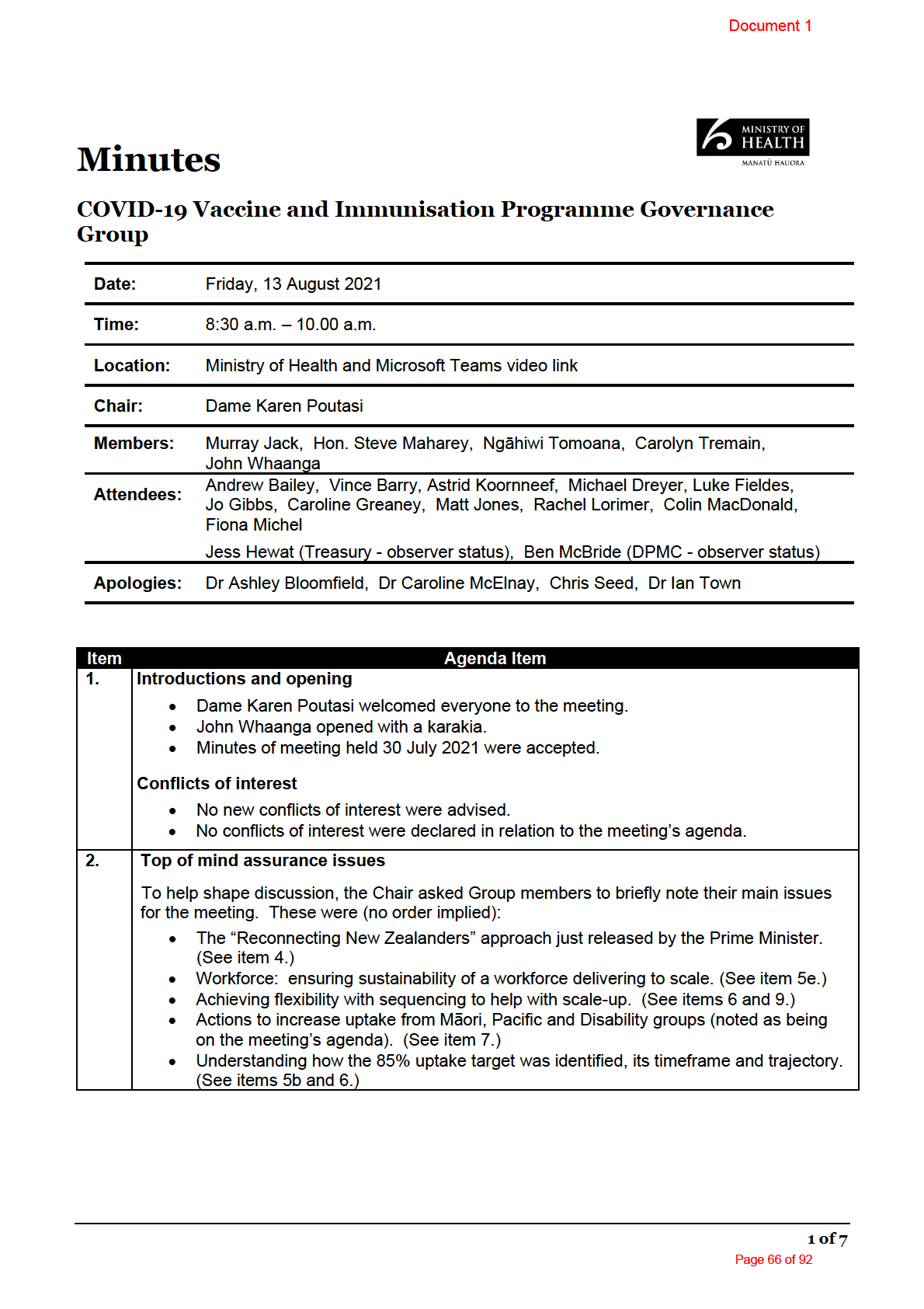
1982
ACT
INFORMATION
OFFICIAL
THE
UNDER
RELEASED
Document 1
2. Other issues
Cont. • Two members noted positively their own personal experience of COVID-19 vaccination.
• The Chair noted she was mindful that the Governance Group must add value to the
programme. As the Ministry continued to strengthen and assure of its ability to deliver the
programme into the future, a review of the Group’s role would be appropriate.
Action 1: Director-General to work with the Chair to review the future of the CVIP
Governance Group at an appropriate point.
3.
COVID-19 Immunisation Programme update (Jo Gibbs)
Paper 4: COVID-19 Immunisation Programme Update – 08 August 2021
• A number of significant announcements this week:
1982
o Announcement of change to the interval between doses (21 days out to six
weeks). Messaging appears to have been well received with only a small peak in
calls at the call centre. Call response times kept to within a minute.
ACT
o Announcement that DHBs who had completed sequencing vaccinations and had
capacity could move to lower age bands early. This was well-received by DHBs.
• Another strong week for vaccination volumes.
• Primary care: DHBs with maritime ports wish to offer vaccination to all port workers, not
just those covered by mandatory testing regime. Wil be discussed with Vaccine Ministers
later that day.
• Small additional supply received from Pfizer means we have been able to build up a
seven-day stock. We have been able to give DHBs some flexibility but continue to
monitor supply closely.
• Have met with Minister Henare re equity planning; also met with ethnic com
INFORMATION munity
leaders. Focus now is to maximise uptake across rest of the year.
• Cabinet wil consider options re vaccination for 12-15 year age group on 16 August. One
option is to allow early entry for dependents accompanying parents. There are
operational implications (including informed consent procedures) to be worked through for
12-15 year olds seeking vaccination by themselves.
OFFICIAL
4.
Reconnecting New Zealanders
Papers 5 and 5a: “Reconnecting New Zealanders to the World” and Prime Minister’s media
release – 12 August 2021 THE
• The Prime Minister outlined five key areas of focus for reconnection, with vaccination
playing a key role. Announcement made that all eligible age groups wil be able to book
their vaccine by 1 September 2021. The elimination strategy wil continue to apply.
• Noted that the Strategic
UNDER COVID-19 Public Health Advisory Group led by Sir David Skegg
had just released three reports on New Zealand’s future strategic approach to managing
COVID-19 and reopening the country.
Group discussion
• In response to a question the Chair advised that the Governance Group and the group led
by Sir David Skegg did not have direct links. However, a government agency CEO group
meeting chai
RELEASED red by the chief executive of DPMC has been updated about the strategic
advisory group’s work.
2 of 7
Page 67 of 92
Document 1
5.
Programme focus areas (workstream leads)
Paper 6: Programme focus areas – 11 August 2021
5a.
Delivering to scale (Vince Barry)
• Programme is reviewing DHB production plans between now and September. Target is
50,000 doses/day delivery on smooth cadence. Logistics are critical to support this.
Mindful of potential impact of external influencers (e.g. wider workforce issues).
• Maintenance of clinical safety is critical. Must also ensure that any issues that arise within
COVID-19 vaccination do not appear more widely.
• Encouraged by the involvement of many primary service providers, including pharmacies,
who view their involvement in scale-up and roll-out very positively.
• Technology: must ensure all key enablers are in place to support scale. Paper being
drafted for Steering Group consideration on this issue.
5b.
Strategy for Uptake (Fiona Michel)
1982
• Noted 85% vaccination target set having regard to research in New Zealand and
international settings.
ACT
• About 20% of primary care providers are delivering vaccination. Larger practices have
been onboarded first. Working to include all primary care providers by end October to
give resilience going into the new year. However, this second group comprises smaller
practices with a smaller overall population coverage.
• All DHB providers have their own uptake strategies through their production plans and
equity plans. Performance is actively monitored by the Ministry.
• CVIP is aware that other countries variously offer incentives for uptake and is reviewing
their approaches.
• CVIP national director indicated that the cross-sector perspectives of Group members on
the draft strategy for maximising uptake would be beneficial once draft is completed.
INFORMATION
Group discussion
• The Governance Group noted that the current response to COVID-19 by “all of Aotearoa
New Zealand” leaves a legacy of built social capital and of trust at a government level, at
a service provision level, etc. New Zealand’s unique situation is a significant ‘prize’ for all
New Zealanders, and adding incentives to inspire individuals to essentially ‘save their own
lives’ seems inconsistent.
OFFICIAL
• We must connect with the right people to promote and enable uptake. The importance of
connecting with local leaders to lead local approaches to reach local communities was
emphasised. The role of the cent
THE re is to support this.
(See also discussion at sections 7
and 8.)
5c.
Stakeholder engagement (Caroline Greaney)
• Need to build and maintain the confidence of our key stakeholders.
UNDER
• Effective engagement is key to ongoing success of the programme.
• Reviewing and refreshing our stakeholder map, and engagement learnings to date, to
identify gaps and opportunities to take forwards into future engagement.
• Currently looking at cross-agency relationships that wil strengthen work with disability
communities
.
5d.
Future State design (Matt Jones)
RELEASED
• Building an assumptions map and a future state operating model for COVID-19
vaccination from 2022.
• The aim is to be able to apply the final product to other vaccination programmes.
Group discussion
Noted the challenges of designing this in a changing landscape, where the science is not yet
fully understood.
3 of 7
Page 68 of 92
Document 1
5e.
Worker vaccination (Fiona Michel)
Workplace vaccination
• Both Fonterra and Mainfreight have completed their first round workplace vaccination with
very good uptake.
• Good response to the request for expressions of interest from other workplaces interested
in offering this service to their workers. These are now being assessed.
• Next priority wil be supermarkets as essential service providers.
• As the government’s wider vaccination approach is to implement age sequencing,
workplace vaccination has been run in parallel.
Mandatory worker vaccination
• Port workers: There have been some pockets of resistance from this worker group. Work
1982
going on to support port employers to have port workers vaccinated including establishing
port-based clinics (commencing shortly).
• Noted that vaccination is now being offered to all port workers whether or not they are
ACT
covered by a mandatory vaccination order.
Group discussion
• Workplace: Noted that there is a wide group of essential service providers at AL4 (e.g.
couriers, power companies, funeral directors) and this group should be assessed to
identify those who must be offered vaccination as an absolute priority.
• Courier companies and those servicing supermarkets are likely to be of higher priority.
Noted that, mindful of the threat posed by the Delta variant, the all-of-government group
led by DPMC was doing some work around the scope of essential service
INFORMATION providers.
• Port workers: Members noted the public reaction to non-vaccinated workers involved in a
previous outbreak. Also noted that the requirements for mandatory testing are phased,
with the last cohort (including some port workers) not required to have completed
mandatory testing until 30 September 2021. In the meantime, members were aware that
maritime port employers were looking at how they could reduce risks in their workplaces
OFFICIAL
e.g. through limiting interactions of certain groups.
(Note: The Group’s discussion on this issue fed into its wider discussion on New Zealand’s
THE
preparedness for a Delta outbreak – see section 8.)
5f.
Vaccinator workforce (Fiona Michel)
• Now have 10,800 trained vaccinators. About half used in the programme to date.
• COVID-19 vaccinators:
UNDER NZQA has approved the training programme. Thirteen people
have met all requirements and are now in the vaccination workforce. 370 people in
training. Initiative positively received by many DHBs/providers. Māori providers were the
early adopters. There is a lot of interest in the legacy potential of this role.
• Vaccinator authorisation: Initial backlog (380 applications) created by the temporary
deferral of authorisation is cleared.
Hands up (surge) database
RELEASED
• Mindful of the undeployed skil set and wider trained capacity in the network. CVIP
therefore now has a dedicated sourcing role to work closely with DHBs and link resources
to them to address need.
• Looking to maximise use of the “Hands up” database by opening up access to providers
more broadly than DHBs. Noted this is still subject to discussion with DHBs.
4 of 7
Page 69 of 92
Document 1
5f.
Group discussion
Cont. • The Group noted positively the legacy work associated with the COVID-19 vaccinator role
and suggested that consideration by given to micro-credentialing these workers to
perform other roles.
• In response to a question, the Ministry confirmed that the timeframe to authorise a new
COVID-19 vaccinator is about a week, providing all correct information is received with the
initial application.
Action 2: Ministry to consider the following for CVIP legacy activity:
a) Consider what micro-credentialing can be done flowing out of the creation and
appointment to the COVID-19 vaccinator role, and
b) Consider how the COVID-19 vaccinator role might endure into the future.
5g.
Workforce sustainability (Group-led)
1982
• Group members noted it was important that the programme can demonstrate that it has
considered the impacts of both scaling-up and prolonged roll-out on the vaccination
ACT
workforce, and that it has taken steps to help to DHBs and other health workforce
employers to manage this.
• Consider actions to keep the essential workforce ahead of the curve, for example, early
vaccination of those in essential services not covered by mandatory vaccination.
Ministry comment
• Aware that many employers are working hard to ensure that vaccination staff maintain
normal working and leave patterns. The Ministry understood this approach is also applied
more broadly across the wider health workforce. Also noted that those in vaccination
INFORMATION
roles were rotated to other related roles e.g. monitoring those in the waiting room.
Action 3: Consider if the Ministry should provide ‘detailed actions’ guidance to
support employers to keep their vaccinator workforce fresh. [Fiona Michel]
(Note: The Group’s discussion on this issue fed into its wider discussion on New Zealand’s
preparedness for a Delta outbreak – see section 8.)
OFFICIAL
6.
Reporting against the Success Framework (Luke Fieldes)
Paper 7: CVIP Outcome Measures – 13 August 2021
THE
• Tracking well on measures other than efficiency. Reasons for poorer performance in
efficiency are that some DHBs have not been able to keep pace with planned capacity
increases, and some have not matched demand. (Noted however that the speed of the
new age band releases may have had an impact on performance.)
UNDER
• Forward bookings are largely second doses; actual vaccinations are largely first doses.
• Noted that the data increasingly provides evidence about gaps in uptake. For example, in
group 3 there is a significantly higher uptake by people aged 65+ years with at least one
long term condition (LTC) than by those without an LTC. This potentially shows that
engagement is having a positive impact for this group. However this is not the case for
the 16-64 year age group with LTCs.
• Noted that some DHBs have started to run out of people in the released age bands.
Vaccine M
RELEASED inisters have agreed to implement 10-year bands in response and this has
been well received by DHBs.
• Acknowledged that current data is sourced from the booking system and thus excludes
primary care.
Group discussion
• The Group noted positively the type of data now able to be provided and the ability to
pinpoint gaps.
5 of 7
Page 70 of 92
Document 1
• It was queried how CVIP was ‘holding’ DHBs to the announced sequencing framework.
Some DHBs appeared to apply more flexibility.
• Closely informs what is needed from Māori and Pacific engagement. But also shows that
some groups wil need more than just messaging to prompt action.
• In response to a question, the Ministry advised that this data was not yet readily available
to DHBs due to the recency of the change to using HSU data as the denominator. The
Ministry was working to transfer DHB data over.
Action 4: Provide the Governance Group with information on the specific actions that
CVIP wil do differently to address the evident gaps showing up in the data. [Fiona
Michel]
7.
Māori and Pacific Communications (Rachel Lorimer)
Paper 8: Communications approach for Maori, Pacific and Disability – 12 August 2021
The Governance Group noted its desire to understand both the broader strategies and the
1982
targeted regional approaches to promote vaccination uptake with an equity focus.
• The Ministry noted that there is no ‘one size fits al ’ approach to engagement. The
ACT
mainstream campaign and funding activities are enhanced by regional and local
communications and engagement activity, led within those communities, and variously
targeting Māori, Pacific and Disability communities and those in younger age groups. The
Ministry has made funding available for many of these local initiatives.
• Ministry feels confident that it has strong networks and capability, and is reorientating
messaging to support strong uptake.
• Noted that local iwi groups are very well engaged.
• Digital campaigns and tools wil start to gain more prominence as open age banding
commences from 1 September 2021. Confirmed that some of these initiat
INFORMATION ives wil be
appropriate for Māori audiences.
• The Ministry undertakes ongoing work to address misinformation where it arises.
Group discussion
• Members discussed the critical importance to scale-up of matching comms and
OFFICIAL
engagement initiatives to the audiences.
• They sought assurance that the Ministry felt it had the right communications strategies
and tools ready for the 1 Septem
THE ber launch.
• Members noted that positive role models and leadership, coupled with continuous positive
promotion, are proving very effective, particularly in smaller communities:
o Community leadership and community spirit in Wairoa has seen over 70 per cent
of the population have their first dose.
o One member had
UNDER helped provide confidence to a group of workers in his
community simply by being vaccinated in their presence.
o Tribal events create opportunities to increase uptake by Māori.
• Members queried CVIP communications preparedness for the changes to the interval
between doses, announced the day prior on 12 August. The Ministry advised that it was
comfortable that direct engagement had taken place with the Iwi Communications
Collective and the Cause Collective to target Māori and Pacific communities. There would
also be a s
RELEASED trong ‘push’ through social media.
• Noted positively the freeing up of age bands from 1 September.
• As an overview, the Group noted there must be a strong link between ‘awareness’ and
‘action’, and there must be agility to respond in areas where resistance is encountered so
that effort still translates into uptake. Leading indicators now give a granular view of
forward bookings. If the effort does not show through in leading indicators then a
significant rethink of engagement wil be a priority.
• (Note: The Group’s discussion on this issue fed into its wider discussion on
New Zealand’s preparedness for a Delta outbreak – see section 8.)
6 of 7
Page 71 of 92
Document 1
8.
Contingency planning for Delta outbreak (Group-led item)
• Members expressed the view that arrival of the Delta variant into New Zealand was a
‘when’ and not an ‘if’, noting the current situation in NSW.
• Considerable discussion took place about the country’s preparedness for the Delta
variant, including contingency planning measures, and the actions that can be taken now.
• Whilst noting the nation’s performance to date, the Delta environment was very dif erent to
that which existed in early 2020 and it must not be assumed that the mechanism that has
reliably delivered to date wil remain effective. To what extent does the approach in the
future programme still reflect the situation of early 2020. There is now a need to advance
thinking against future risks - what wil we do significantly dif erently in order to address
Delta?
Vaccination readiness
1982
• Under AL3/4, essential services remain open. Members are strongly of the view that
workers in these services, whether or not subject to mandatory testing, should be fully
vaccinated well ahead of the current vaccination curve, and should receive their first dose
ACT
as soon as possible. Members expressed the view that for many, they did not think a
second dose would be possible before Delta was detected in New Zealand.
• Port workers were of particular interest to the group. However the scope of essential
services could usefully be reviewed and broadened from a vaccination perspective.
• It was queried if planning allows for vaccination to continue in an area exposed to the
virus. One member suggested this was something that the AOG group was already
considering.
All-of-government readiness
INFORMATION
• The Chair noted that, from an assurance perspective the Governance Group does not
have visibility of the intersect between the vaccination programme and the separate
testing programme also led by the Ministry. This ‘joined up’ overview was something the
Governance Group indicated it needs to support its wider conversations with and
assurances to Ministers.
OFFICIAL
Action 5: National Director to link with Carolyn Tremain re the all-of-government
interface, and to clarify the vaccination/testing interface within the Ministry, for report
back to the Governance Group.
THE
9.
Sum-up of Governance Group’s focus areas for the programme arising from meeting
• Members of the Governance Group noted their strongest interest area and concern at this
point was the whole-of-government response to a Delta variant outbreak, and the actions
that can be taken now from the vaccination perspective to help to protect New Zealanders
from COVID-19. The im
UNDER plications for New Zealand of another COVID-19 outbreak are
now much broader than just having the disease in the community.
• Achieving equity remains a focus for the Group. We must trust local approaches in local
communities. The most effective actions wil be a combination of Ministry-led
communications and engagement activities that supplement the actions of local trusted
community voices who can push reach and strengthen acceptance.
10.
Meeting close
RELEASED
The meeting ended at 10.00 a.m.
Ngāhiwi Tomoana closed the meeting with a prayer.
11.
Next Meeting
Friday 27 August 2021, 8.00 a.m. – 10 a.m.
7 of 7
Page 72 of 92
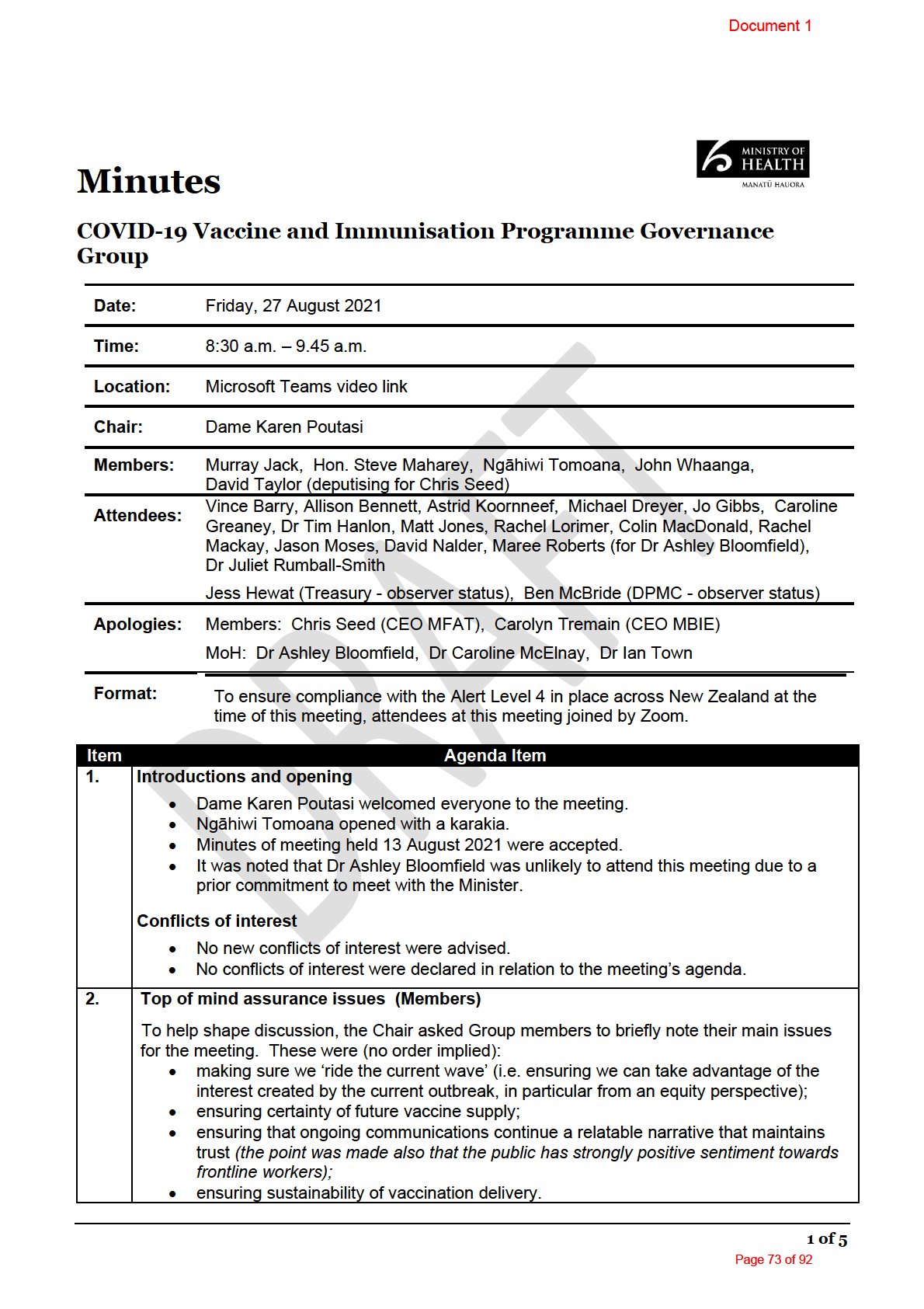
1982
ACT
INFORMATION
OFFICIAL
THE
UNDER
RELEASED

1982
ACT
INFORMATION
OFFICIAL
THE
UNDER
RELEASED

1982
ACT
INFORMATION
OFFICIAL
THE
UNDER
RELEASED

1982
ACT
INFORMATION
OFFICIAL
THE
UNDER
RELEASED

1982
ACT
INFORMATION
OFFICIAL
THE
UNDER
RELEASED

1982
ACT
INFORMATION
OFFICIAL
THE
UNDER
RELEASED
Document 1
• The Ministry recognised our strategy is to vaccinate as many people as possible and
not set a target percentage.
• It is recommended not to leave the hesitant and unengaged part of the community
until last and that we should focus communications on these groups specifically.
• Ministers are requesting further information, in particular equity data. We are
continuing to pull out all the stops to assist our political champions for the programme.
• There is concern about younger age groups being vaccinated as the bulk of the
population is under 40 and a significant group is under 25. We should be tailoring our
communications campaign to these groups.
• A more focussed partnership with Iwi chairs and Ministers, who are strongly supportive
of our approach and vaccination programme, should be utilised moving forward.
• It is acknowledged that there is 6 or 7 workstreams working in this area but that they
are not as well connected as they could be. There are also some great methodologies
that we could take into the wider vaccination programmes if achieve the legacy.
1982
Action: Ability to utilise current methodologies and opportunities to create a legacy for the
wider vaccination programme moving into the next year. Chair to discuss with the Director-
General and add an item for next meeting. (Dame Karen Poutasi)
ACT
3.
Vaccine Supply (Jo Gibbs / Al ison Bennett)
• The item under Strategies for Uptake on the agenda wil capture most of the areas of
this item.
• Vaccines landing at 11:20am this morning. The logistics and operational plan for this
wil see customs work and release these by 5pm tonight and then provide additional
supply to Auckland arriving Sunday morning.
• There is another deal underway from Europe for 500,000 doses. This
INFORMATION will be
announced next week and wil run with the same process as the recent delivery.
Batch numbers have been approved by Medsafe and the Bilateral agreement is ready
to be signed.
• Pfizer has agreed to send 200,000 more doses which wil arrive between September
and October.
• The Ministry would like to note that although numbers of vaccinated people appear to
OFFICIAL
be reducing, 65,000 doses were completed last week, and the data indicates this is
due to the reduction on alert levels.
• This weekend there is a full communications campaign expected and walk-in clinics
THE
will be available.
• Technology is working on identifying areas through the book my vaccine app to enable
the public to see digital maps of where walk-ins are.
• Geospatial data is available now and we see that rural areas have a lower turn out
that urban areas. We can see specific small rural areas have done well as these have
UNDER
been targeted, however larger rural areas closer to urban areas have not as there was
an expectation, they would travel into urban area clinics, but this has not happened.
Strategies to lift uptake wil be discussed in the next agenda item.
• There was a debrief with the IMT team recently where being clear on urban, rural,
younger people, equity, Māori and Pakeha strategies was highlighted.
The Chair and the Ministry recognise, and is very grateful, for the effort undertaken by MFAT,
MOH and all those working around the clock to complete the policies and logistics required, to
RELEASED
produce such an amazing achievement. Congratulations to the team for securing doses and
responding so well under the scenario of trying to vaccinate at the same time as an outbreak.
4.
Strategies for Uptake (Fiona Michel / Jason Moses)
(This item was meant to be presented fifth but was switched during the meeting)
• This has been reprovisioned as was previously part of Mat Parr’s role who is no longer
working on the programme.
2 of 5
Page 79 of 92
Document 1
• There has been a new working group created to look at this with the optimisation team
looking at the day to day working.
• This working group wil assist us to see any pain points through great data. We’l be
able to understand what is happening in areas, proving expert support when required.
• We are actively looking into taking ideas around incentives to the next steps. We’re
working with the wider vaccination programme to understand how they’ve used
incentives in the past. Currently it looks more like enabling wil work better, that’s
providing transportation and connecting with like-minded groups, including workplaces
and a mixture of private and public services to help with delivering vaccinations.
• There are lots of workplaces working hard to provide vaccinations for their employees.
• Ministers have been advised by the Ministry that an extension to the health order to
see how it covers all of New Zealand should be considered along with a more granular
personalisation.
• Data can be used to see who isn’t responding to invites to be vaccinated so we can
reach out to these areas. There is a Mr Whippy model being discussed where we
1982
show up in the street and work with people locally.
• There is an alternative to Pfizer vaccine available as it may be that people want to be
vaccinated but not with the Pfizer vaccine. We are considering how best to approach
ACT
this group of the community to offer an alternative.
• We need to stay connected to our communities and Māori health providers as there is
a lot of value here, including if we need to move quickly as we saw during the
lockdown.
• There is a large focus on communications in these areas from Rangatahi and Iwi
communications collective and a specific target response for Māori given that’s one of
the key gaps at the moment. Providers are also looking into incentives and some
have already implemented these in their communities.
• It is encouraging to see momentum in this space and personalisation of this is likely to
have the biggest impact on vaccination rates. Communications need t
INFORMATION o shift to get
that last 20-30%. We need to experiment and be more proactive. Providers wil need
data to see who hasn’t been vaccinated in their areas so they can communicate with
them directly.
• We suggest that all government agencies, when communicating with people, should
be asking, have you had your vaccine yet? Having employers do this would also be
helpful.
OFFICIAL
• There are workplace debates starting and we are looking at possible Health & Safety
legislation conflicts.
• Ministers wil be lobbied about
THE workplace vaccination and Health & Safety legislation.
• Any assistance we can provide across the government to remove barriers including
information sharing and legislation nature should help to ease some of these.
• One of our biggest opportunities for equity is in providing walk-in vaccination clinics
and next week these wil open to everyone.
• We have a very good c
UNDER ohort of people for each age group and ethnicity health
utilisation database, so we know who hasn’t responded. With data we can look at the
area, post code, ethnicity and can target our approach.
• We have done personal invitations as the dif erent age groups have rolled out and we
are supporting different ways of communicating and seeing what people might be
more likely to engage with.
• Talking to social science experts will identify techniques to bet er communicate with
communities, including through community based discussions to assist in mobilisation.
RELEASED
• There are 136,000 out 900,000 Māori not affiliated to an Iwi. We need to look at a
personalised approach for this group especially as 8-9000 don’t have easy access to a
provider.
• The Communications Campaign is reorienting themselves to a new phase. Our
approach has done well up til now and the next phase is segmentation and specific
messages to individual groups, including stakeholders and those on the ground who
need to hear from us.
• We are reviewing behaviour and interventions also and strengthening our messaging.
Information on safety, protecting yourself, whānau and reconnecting with the world are
3 of 5
Page 80 of 92
Document 1
key focus points along with interconnecting sites and moving quickly to utilise touch
points.
• MSD have fliers going into foodbanks during lockdown. Electoral commission is
helping to target small communities. We are continuing a broad approach and also
targeting under 30s through more shareable channels to get through to youth,
including the radio. We are looking at geographical data to specifically target radio to
these areas.
• Emotional communications work well. Our previous messaging about recycling
rubbish, seatbelts, smoking created huge influences in our children. The children
influence adults to make changes. How do we use that influence and the effects of
children as we did on earlier campaigns?
• There are some negative messages out there, how do we turn these around to
positive messages? Iwi chairs and Māori health providers are able to go into Māori
communities and partnerships. We should be utilising this much more. Targeting
100% vaccination rates by Christmas for Iwi. Unless we get ambitious, we wil be held
1982
hostage by the negative messaging.
• There is an expectation that DHBs have links to local Iwi, and this should be
complimented by nationwide connections with Iwi.
ACT
Action: Next steps of Strategies for Uptake to come to next PLG meeting (Fiona Michel)
5.
Booster Vaccines (Dr Ian Town)
(This item was meant to be presented fourth but was switched during the meeting)
• CV-TAG is reviewing.
• Third doses and incidents of missed doses our focus at present.
• Myocarditis is with the safety board for review.
• Janssen as an alternative is being fine-tuned. INFORMATION
• Influenza vaccinations are continuing and are being considered as part of the wider
integration plan.
• Extra vaccines for the immunocompromised, border workers, certificates, and
vaccination status for returning New Zealanders as a high proportion have been
vaccinated.
• Minister Hipkins was advised regarding Pfizer and a science discussion with the Pfizer
OFFICIAL
science advisory board regarding need for boosters and the trials they are currently
running.
• The Janssen vaccines wil be approved for future use but not for booster shots in the
THE
first instance although may be something to consider for next year.
6.
Future Assurance Activities (David Nadler)
There are six areas of assurance.
UNDER
• Our intention is to leverage assurance activities already underway.
• Utility safety and incident manager.
• Tech assurance.
• Audit for logistics.
• Debrief on IMT group.
• OAG come back.
RELEASED
• Follow up audit process important, however there is no timing or shape of the exercise
yet.
• We are signalling to the wider sector for them to self-assure, service standards
including performance, and understanding clinic leads have the right oversight in
place. A self-assurance confirmation in place.
• We have continued to be clear assurance work is required and the expectations of
these functions.
4 of 5
Page 81 of 92
Document 1
7.
Risk Updates (David Nadler)
There are some key themes:
• Risk and opportunity.
• Delta is the biggest opportunity to the programme on working with risk, public apathy,
scaling quickly, contingency programmes. All these plans have been activated and
working well.
• IMT sped up our decision making process. The debrief and positive opportunity that
could continue, including new delivery models, drive, and approaches.
• The challenges identified in the risk paper including sustainability of volumes and
enduring over the next few weeks of the programme, as there is an end in sight.
• Strategy for Uptake to reach hard to reach people.
• Future state looking at 2022 and beyond. Items built out of programme can continue.
• Inherent risks in the programme didn’t change but prominence was more immediate.
1982
• Risk only makes a difference if it feeds into decision making.
• Complexity as we have different parts of New Zealand in different alert levels.
ACT
• Managing this part of the programme has many levels.
• Materially increase of scale and wider pressure in health workforce.
• Risk of clinical issues emphasis needed for incident identification and escalation so we
hear and can respond quickly.
• Data quality issues. Providers entering vaccinations into CIR. Data quality around all
sorts of things, duplications, names are wrong. Providers have gone to paper instead
of CIR. There is work being done on this. As we move into certificates this wil
become more critical.
• Emerging issues with travel and certificates if the data quality issues aren’t fixed.
• There is a complex piece of work to see the data coming through and c
INFORMATION an issue letters
to confirm vaccinations. If this af ects 1% then this will be tens of thousands so need
fix as soon as possible.
• The technology team wil require further support to resolve data quality issues.
The Ministry congratulates the team for stepping up and getting numbers through as this has
been astonishing. We also recognise the good work on contingency planning and the risk
work David has done has created a strong platform.
OFFICIAL
Action: Return to PLG at next meeting with resourcing requests. (Michel Dreyer)
THE
8.
Any other business and close
No other business.
9.
Meeting close
The meeting ended at 10.00 a
UNDER .m.
Ngāhiwi Tomoana closed the meeting with a prayer.
10.
Next Meeting
Friday 24th September 2021, 8.30 a.m. – 10:00 a.m.
RELEASED
5 of 5
Page 82 of 92
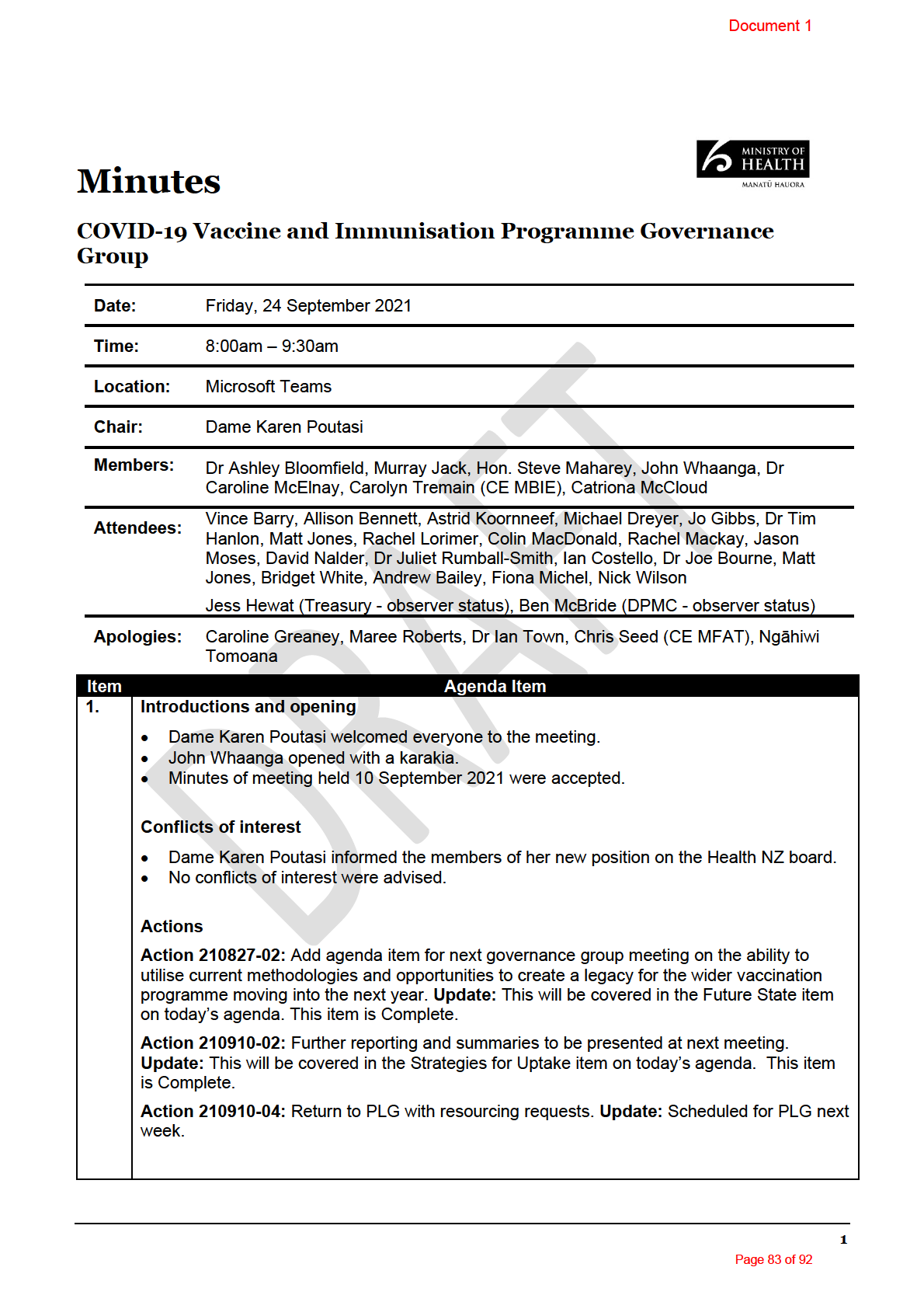
1982
ACT
INFORMATION
OFFICIAL
THE
UNDER
RELEASED

1982
ACT
INFORMATION
OFFICIAL
THE
UNDER
RELEASED

1982
ACT
INFORMATION
OFFICIAL
THE
UNDER
RELEASED
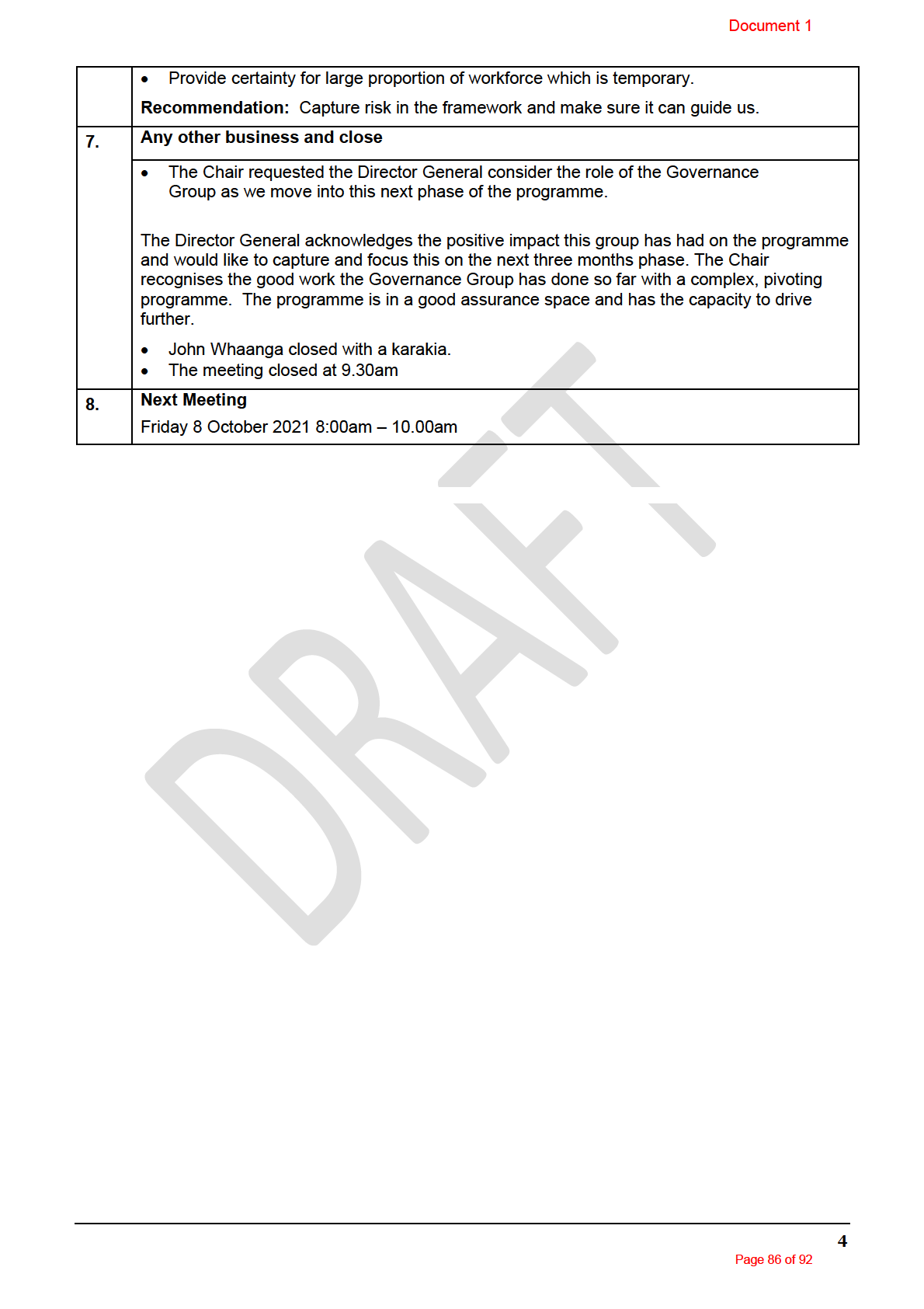
1982
ACT
INFORMATION
OFFICIAL
THE
UNDER
RELEASED
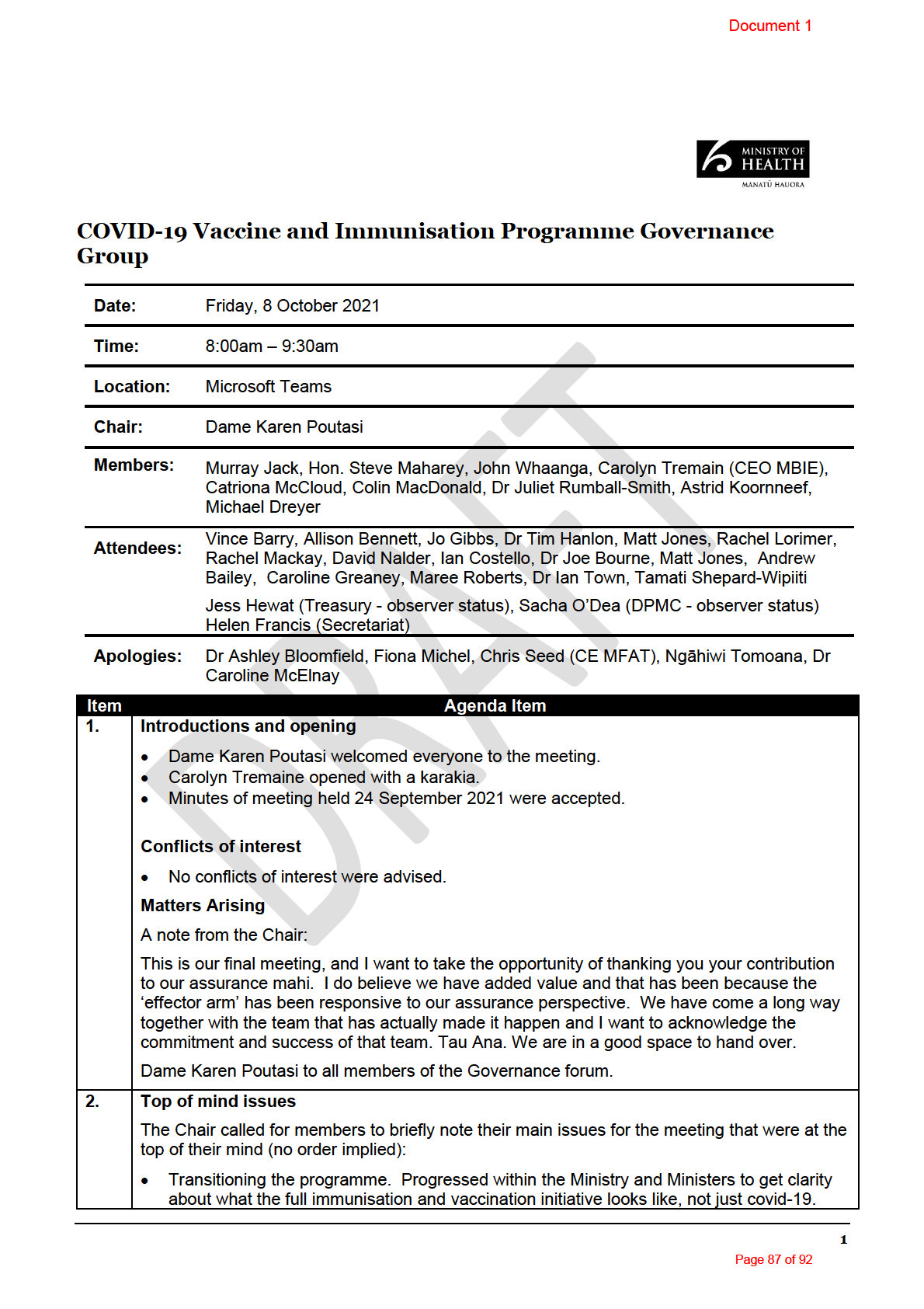
1982
ACT
INFORMATION
OFFICIAL
THE
UNDER
RELEASED

1982
ACT
INFORMATION
OFFICIAL
THE
UNDER
RELEASED
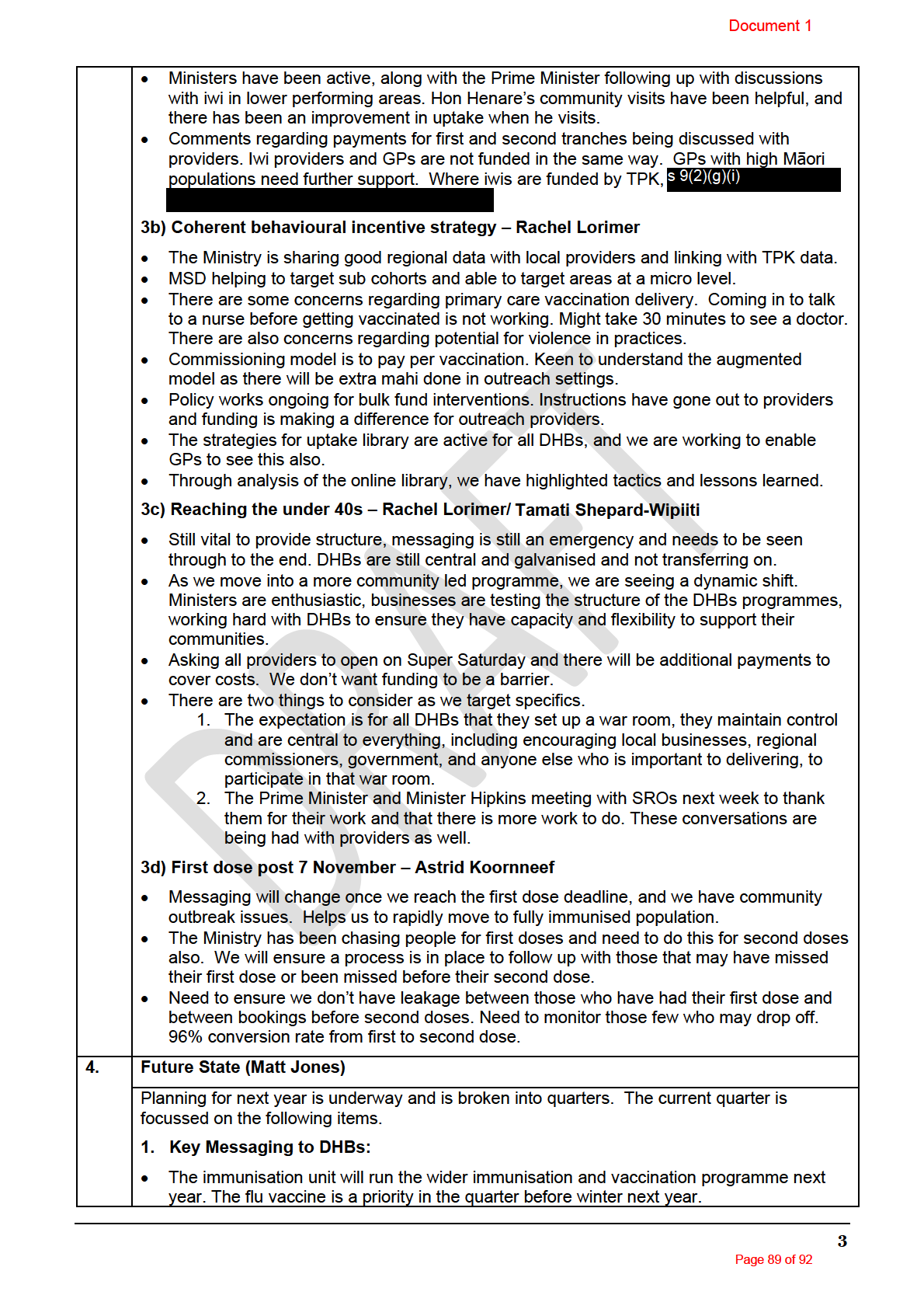
1982
ACT
INFORMATION
OFFICIAL
THE
UNDER
RELEASED

1982
ACT
INFORMATION
OFFICIAL
THE
UNDER
RELEASED
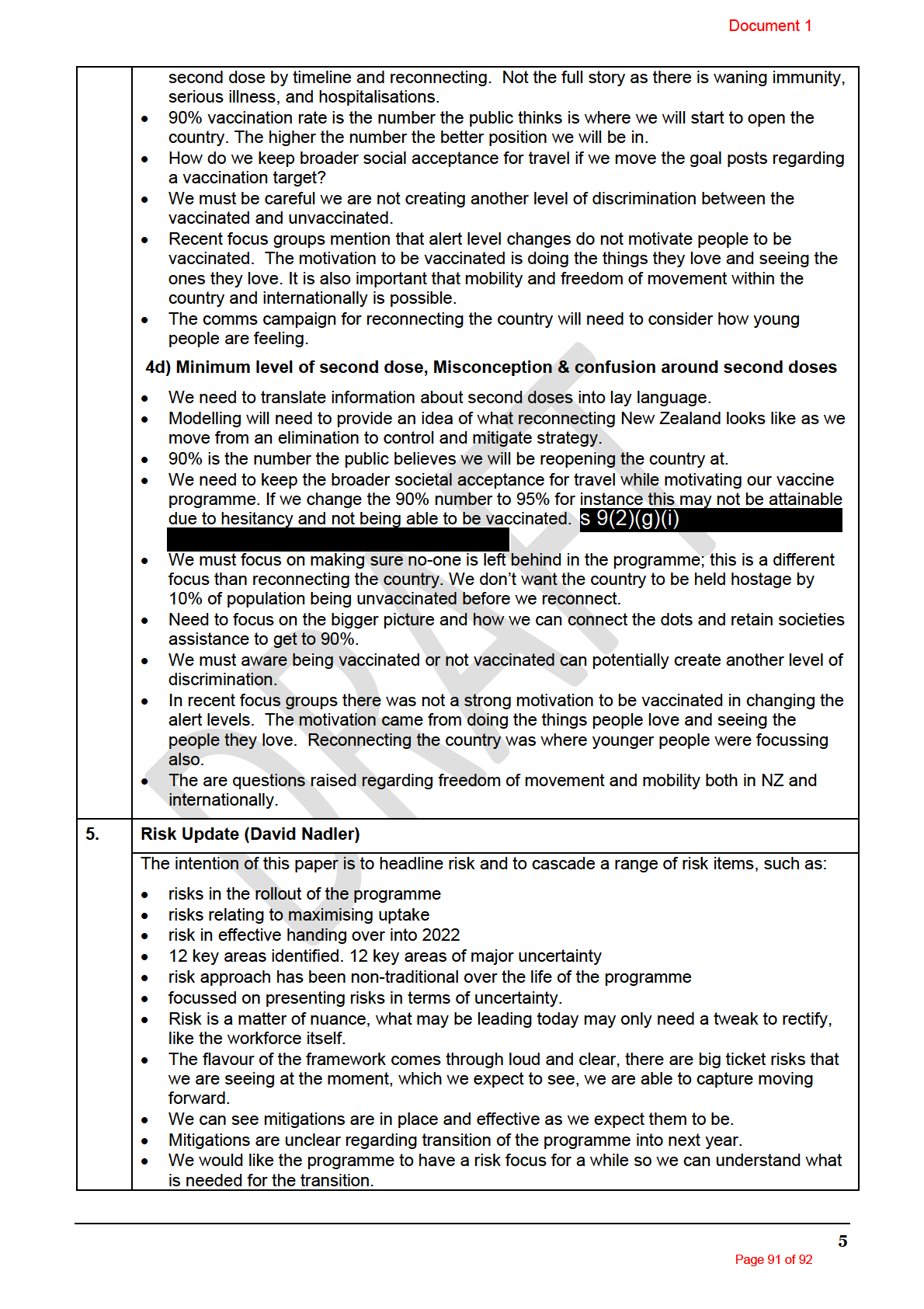
1982
ACT
INFORMATION
OFFICIAL
THE
UNDER
RELEASED
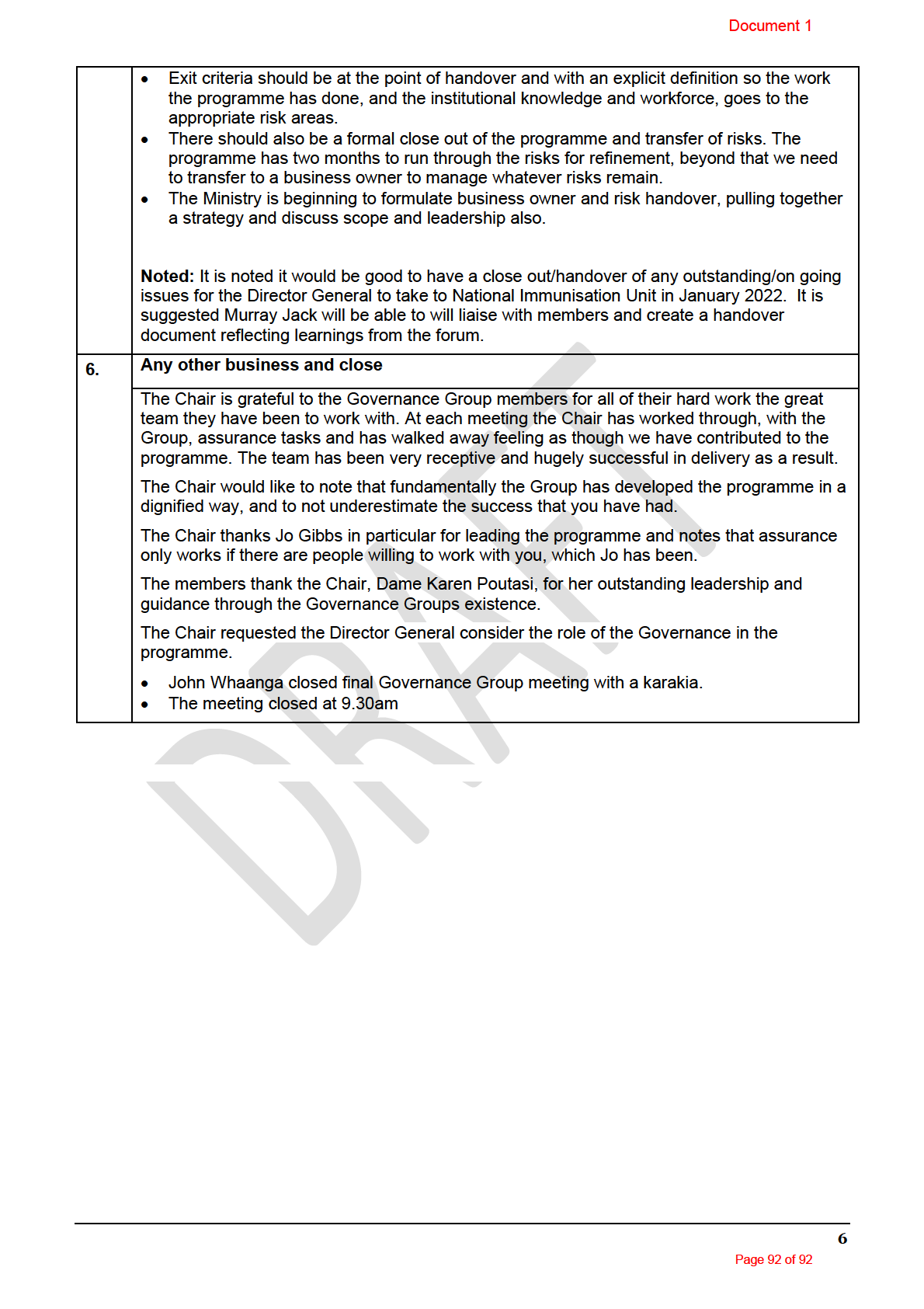
1982
ACT
INFORMATION
OFFICIAL
THE
UNDER
RELEASED










































